Fashion fans, the time has come! Though it feels like mere moments since we spoon-fed you the best bits menswear had to offer, get ready, get set, and get in because we’re going to New York Fashion Week! Coming to you live from the Big Apple, with even bigger news — Heron Preston is back, as is Thom Browne; Palomo Spain is in town; and Willy Chavarria and LUAR are set to deliver the kind of spectacular closing shows we all deserve. We’ll be running around town to catch all your favourite shows, from Collina Strada and Eckhaus Latta, to Elena Velez, but fret and fomo not, my friends! We’ll be capturing all the must-see moments from the runway, so all you need to do is check in here for the latest. À bientôt!
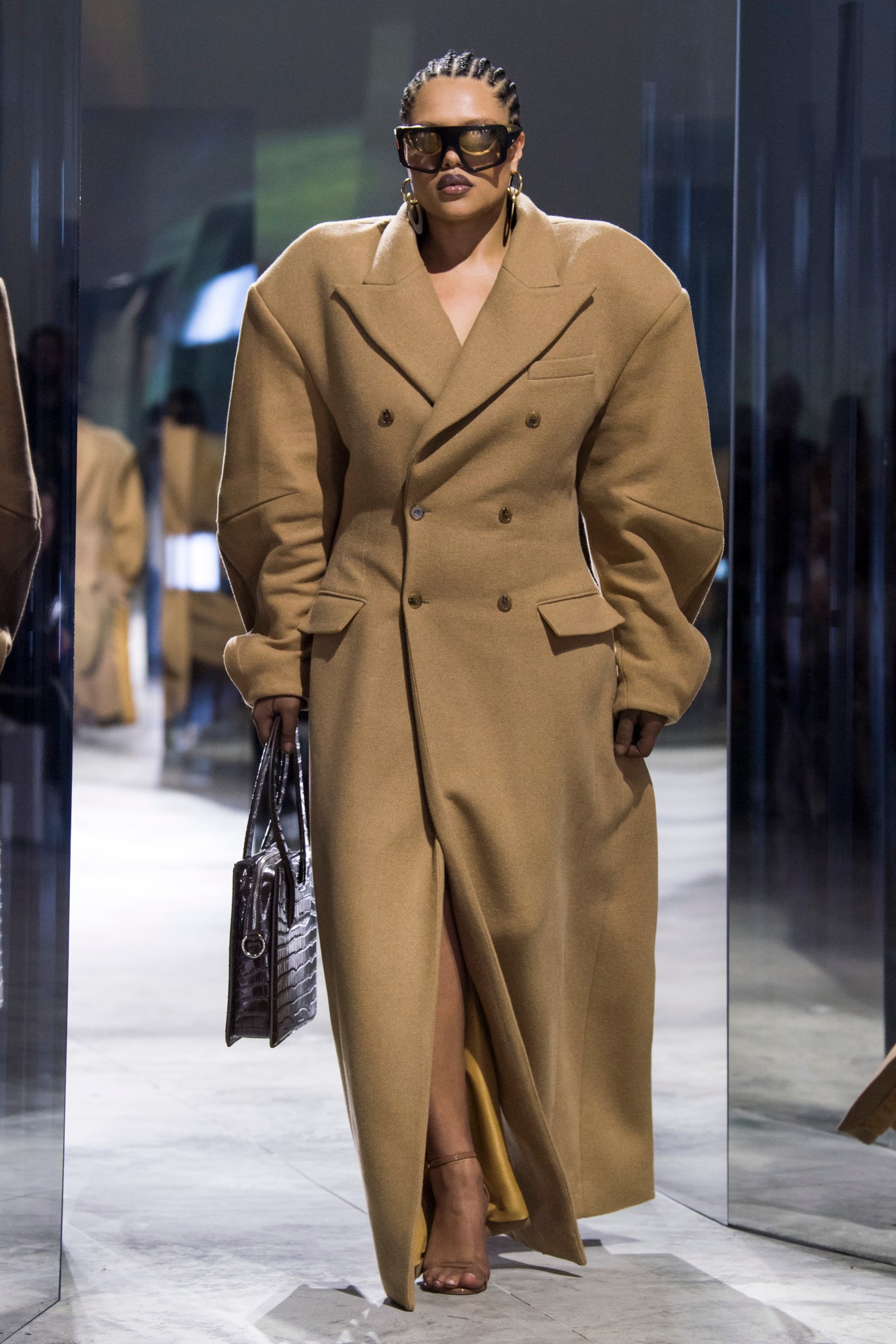
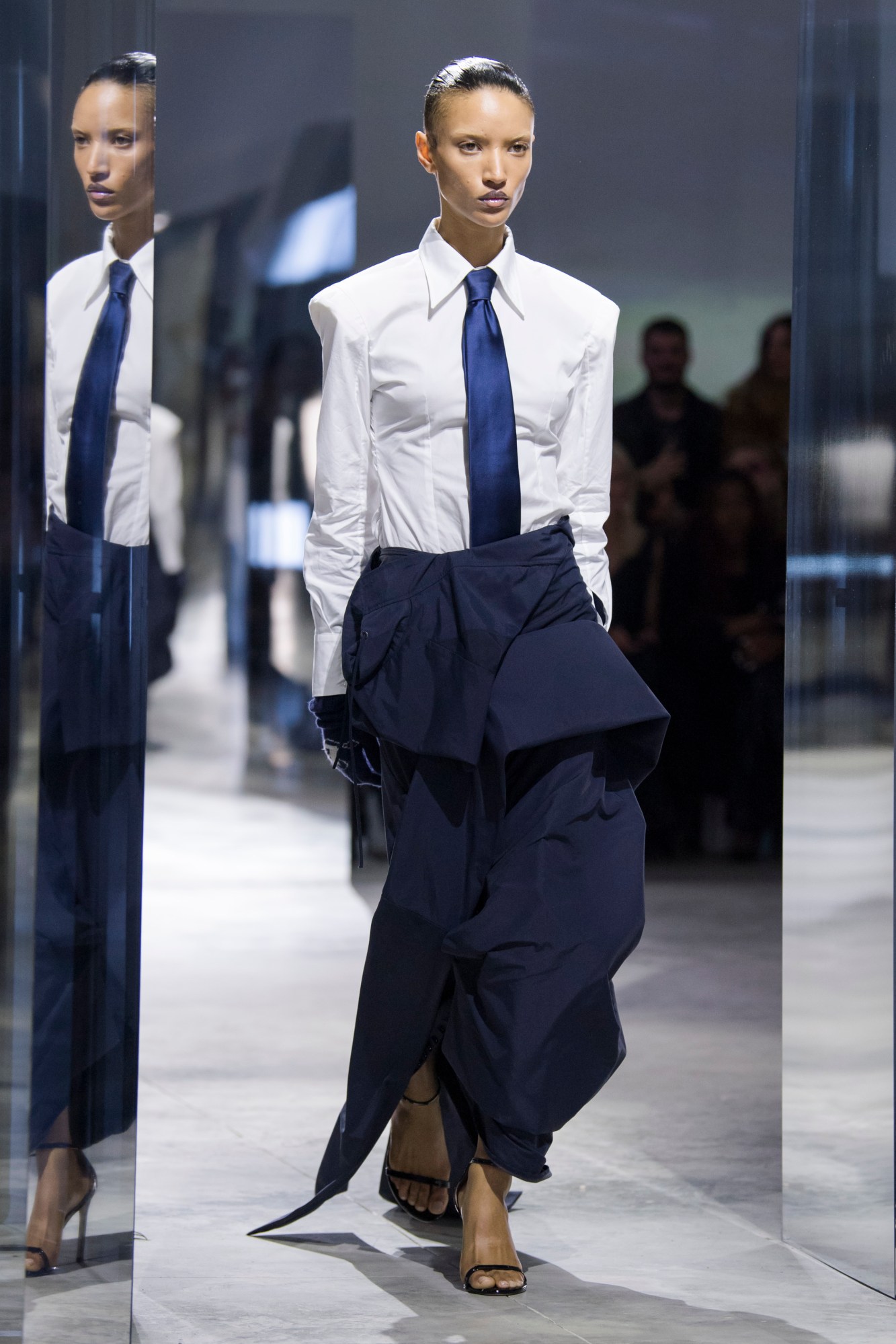
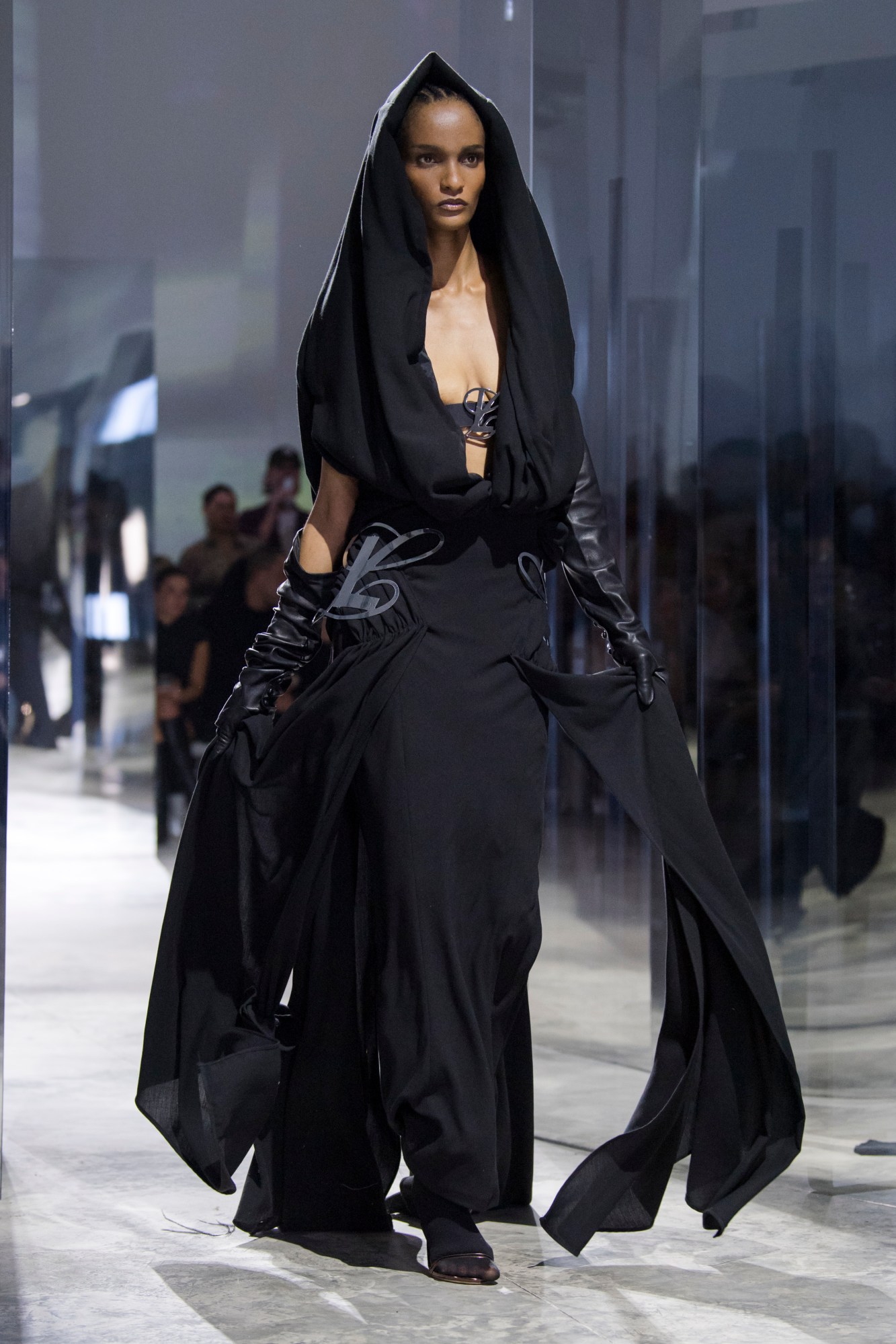
Luar
Though no doubt with a bit of a hangover, Raul Lopez must have woken up pretty damn pleased with himself this morning. Not only did the announcement break that he’d made the semifinal of the 2023 LVMH Prize, but he managed to close out New York Fashion Week with easily the most memorable moment of the season with his namesake (well, it’s his name spelled backwards, so close enough) brand Luar — and one that will no doubt continue to stand out even by the time the Paris shows come to a close in just under a month’s time.
The spectacle began long before the first model even walked out – the clamour outside the show venue itself was a physical articulation of the buzz that had built around the event. After the high drama of last season’s show at the Shed, it was common knowledge that this was set to be the show of the season; a moment that no fashion fan in town could forgive themselves for missing. Among those that turned up were creative stalwarts like A$AP Ferg, Jeremy O’Harris and Tyler Mitchell, though unlike most celeb-filled frows, where attendance is typically tied to a brand partnership, they were there as members of a community brought together out of sheer love and admiration for the designer and his work.
Those feelings were evidently mutual, with each look that filed down the runway reading like a love letter to the broad cast of characters that figured in Raul’s life. Titled ‘Calle Pero Elegante’ — Spanish for ‘street but elegant’, he presented a series of odes to the bold, bolshy women — or “gangstresses”, as he calls them — he’d see on the streets of Williamsburg growing up. Women that could command a room with the flick of a French-tipped finger.
Enchanted by their simultaneous give-no-fucks attitude, self-assurance and glamour, he began to reflect on how the codes by which they lived were entirely of their own choosing. Rather than abide by others’ ideas of how they should carry themselves or what they should value, they were people entirely in command of themselves, the way they lived their lives and the impressions they left behind.
This notion of legacy directly informed Raul’s design process, leading him to reimagine their hallmark garments as precious heirlooms — the sort of things that would embody their spirit and carry it forward for generations to come. Models stormed the runway — often to ear splitting cheers — in linebacker-shouldered coats and gowns, done in crisp grey tailoring wools and camel, had an irrefutable permanence to them — sculptural and solid. A glossy ink-hued fur sported by José Castelo Branco was indeed the sort of thing that you’d hope to one day have passed down to you, and an abbreviated sable capuche coat exuded the glamour of 80s Saint Laurent, as did a suite of floor-sweeping gowns with revealed busts and riding hoods.
A sportier tone came through in intricately panelled leather biker and nylon technical jackets — a nod to Raul’s own collection of similar pieces dating back to the 70s and 80s. Elsewhere, staid office garb was reimagined, with slim poplin shirts given oversized shoulders, and the pinstriped of tailoring wools darned with a subtle rainbow shimmer. And, of course, Luar’s flagship heirloom — the Ana, the viral top-handled tote that takes its name from both Raul’s mother and grandmother — appeared from micro to close to travel-trunk-sized proportions.
Once the show had come to a close, and the audience had picked their jaws up off the floor, the drinks carts were rolled out, swiftly turning the affair into a raucous party. It was a fitting way to see out what felt like a defining moment for Raul and his mission with Luar — after all, the legacy he’s laying down is one well worth celebrating. MS



Willy Chavarria
Days before his AW23 show, Willy Chavarria was fitting models with his team in his Greenpoint studio. After each person was dressed, he’d instruct them to walk through the space with a slightly feminine ease and elegance, making eye contact with the eventual audience. ”This season the walk is very important because I really want to portray the most elevated form of fashion,” he explained. “I want the world to see me as a serious designer. I’ve always had a lot of playfulness in my work, but this is my most serious collection.”
Other words that the designer used to describe his latest offering were romantic, elegant, loving and sad, and last night at the Cooper Hewitt Smithsonian Design Museum, a full range of emotions were felt at the runway show. Upon entering the historic, dark-panelled halls of the Georgian revival mansion and taking their seats under the chandeliers, guests were greeted with the sounds of a string quartet. Dorian Wood walked down the massive carpeted stairs singing “Piensa en Mi”, in a black ruffled gown, and the stage was set.
Inspired by 80s love song “Kangaroo” by This Mortal Coil, and titled as such, the nearly all-black collection was an extremely powerful and moving proposition for menswear. All sweeping silk and satin trousers, exaggerated shoulders and pussy bows, floor-length skirts and boiler dresses, it was designed without gender in mind and to celebrate a variety of different expressions of masculinity. This season also saw Willy working more closely with ateliers and expert patternmakers to push his tailoring into more evolved iterations of his signature oversized silhouettes: velvet robelike overcoats, clean wool double-breasted jackets with dramatic collars, a cropped and a belted wide-lapel number that appeared so striking cutting through the room.
“It’s beautiful. It’s very loving, intimate and dramatic,” he said of the song, which he kept playing on repeat throughout the design process, though this is also an apt description of the show. “I kept thinking about the climate of the world. Kangaroos are very loving. That stuck with me and so I wanted this collection to feel very protective and loving, but also on my highest tier yet of tailoring and fabrications.”
The only pops of colour that appeared throughout were gardenia white — a silk scarf curling across the neck, draped over a bomber jacket with white piping details, lining the lapel of a sharp floor-length coat, the flower itself, pinned over one’s heart. The inspiration came from Willy’s mom, who used to wear a single gardenia in her hair, just like Billie Holiday. Now that’s elegance. ND
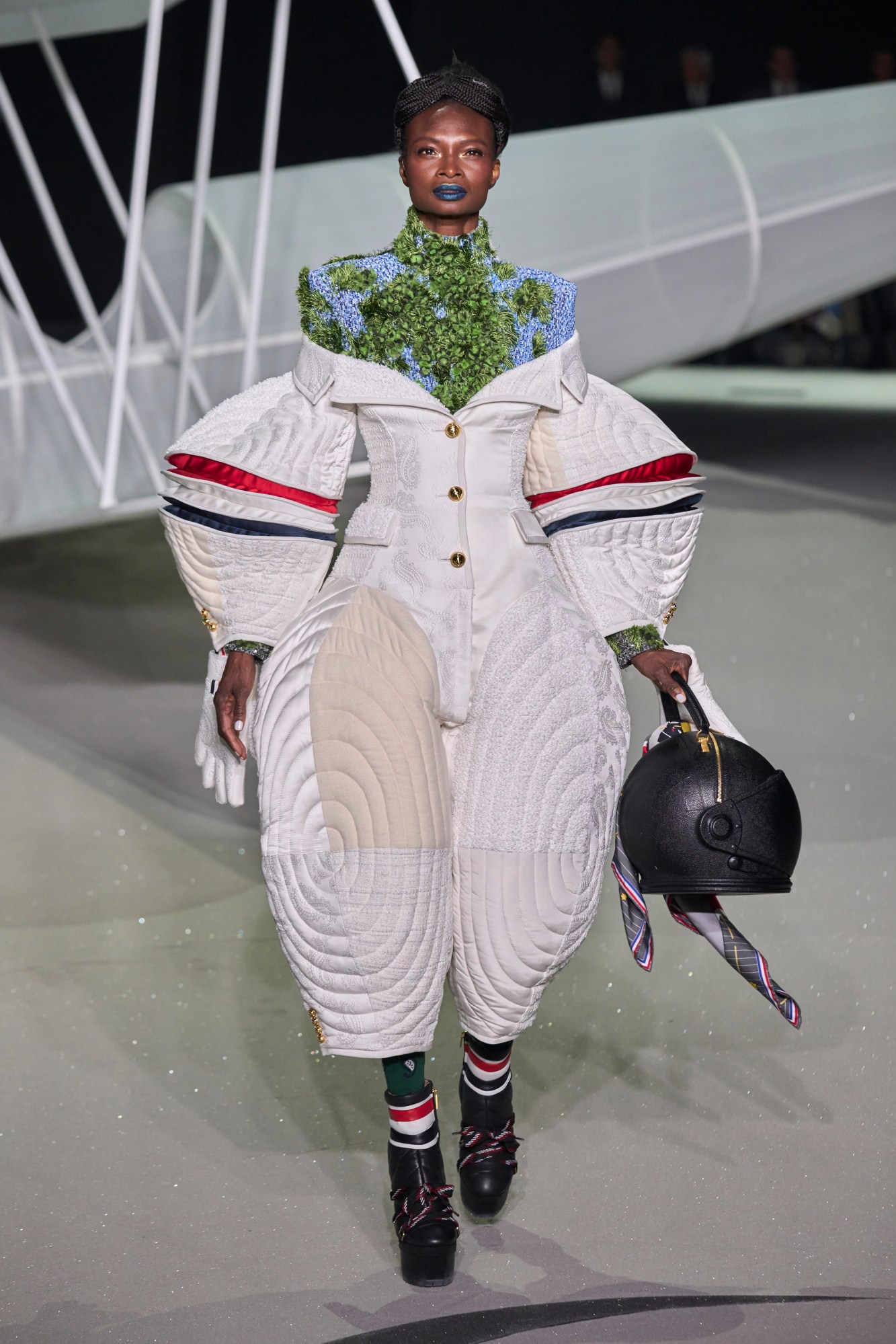
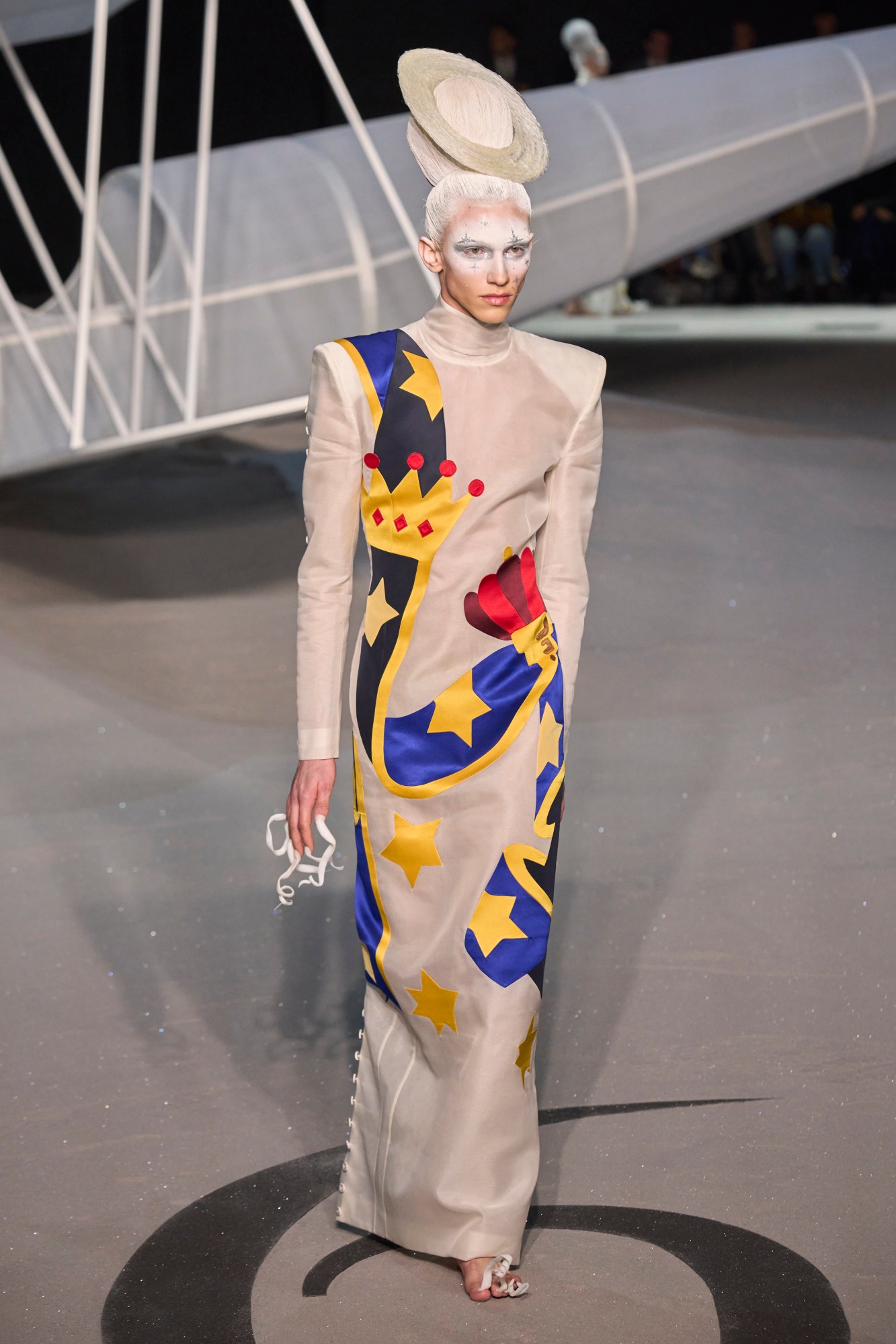
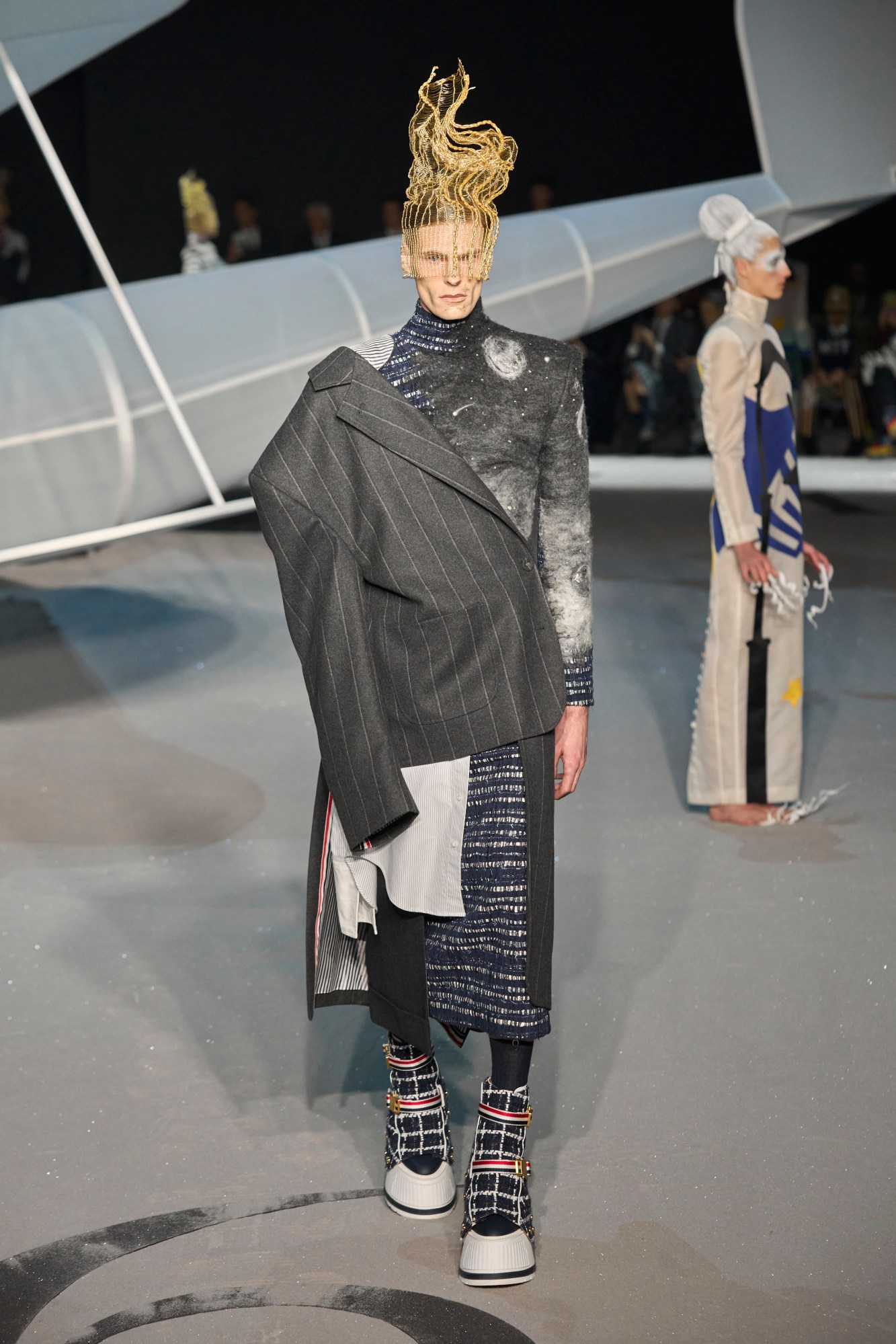
Thom Browne
For his return to New York Fashion Week, as part of his new role as Chairman of the CFDA, Thom Browne took over The Shed at Hudson Yards. At the room’s centre was an antique plane crashed into the sand, swirling stars and planets suspended from the sky above it, all anchored by a clock face on the ground. Both the lavish set and the musical theatre of his SS23 show at the Palais Garnier in Paris hinted that we’d be in for quite the spectacle, and one thing about Thom Browne is that he will deliver.
This season, the collection explored loneliness, loss, determination and exploration via an adaption of Antoine de Saint-Exupéry’s The Little Prince; his aircraft pilot dressed in a blown-out, quilted space suit accentuated with the label’s signature, red, white and blue stripes, and the prince, wearing a two piece grey tweed jacket over a knit dress, coming undone and threaded with gold.
The show really leaned into the fantasy, over nearly 40 minutes, and was presented over a number of sections – the first, comprised of outsized tweed jackets and suiting; then long plaid and paisley sheath dresses played with patterns and proportion, cutting into the mid-section to delicious trompe l’oeil effect; the show closing with upcycled couture looks reimagining classic Thom Browne tailoring elements – the stripes, the labels, the pleated skirts – layer by layer. Precious Lee closed the show in a jaw-dropping all white look, the skirt of her gown taking the form of various silk suit jackets, spliced together, and trailing across clock as if welcoming the passage of time. The very A-list front row, featuring Erykah Badu, Lil Nas X, Pusha T, Penn Badgley and more, erupted into raucous applause for Thom Browne – New York fashion’s hometown hero had returned. ND
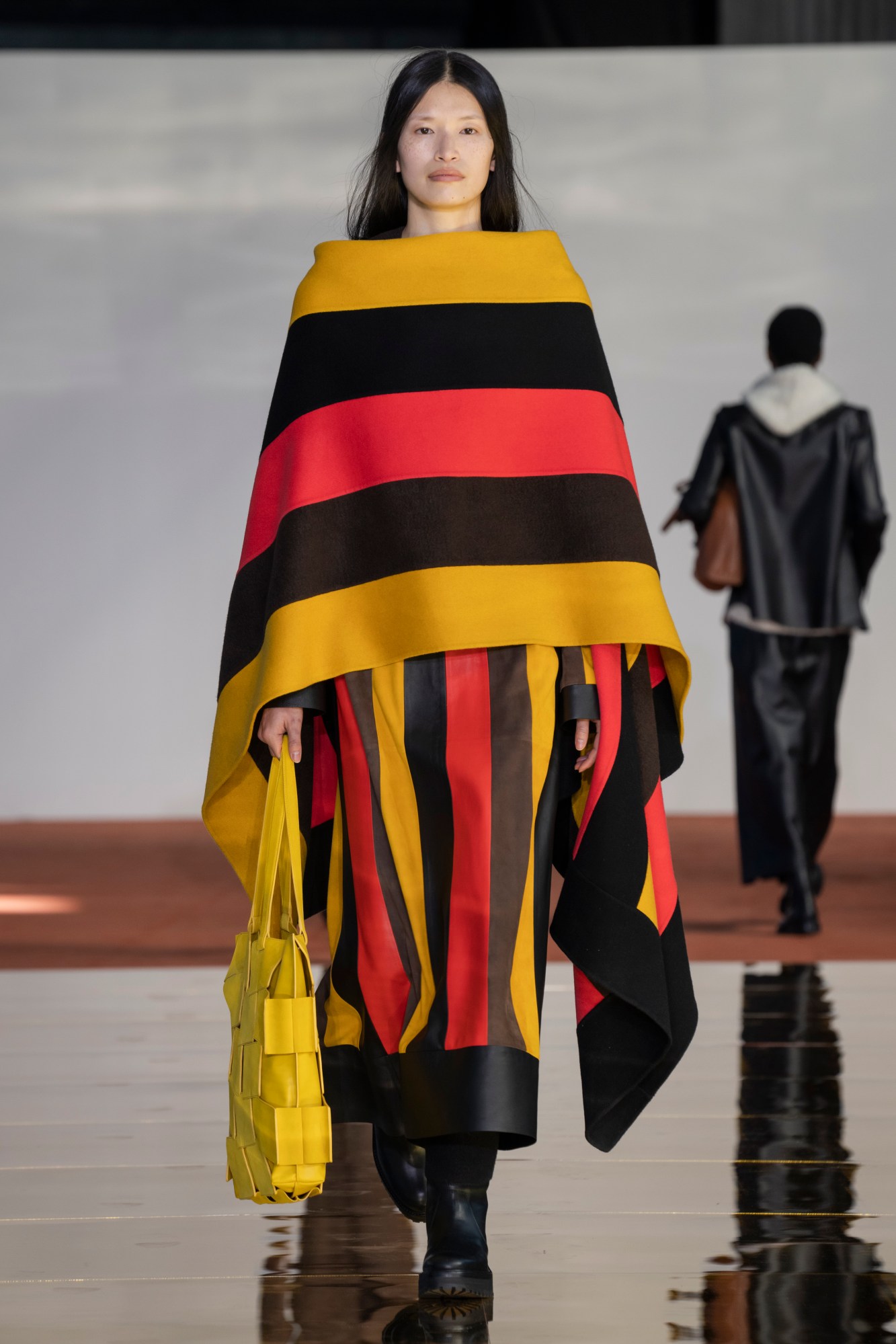
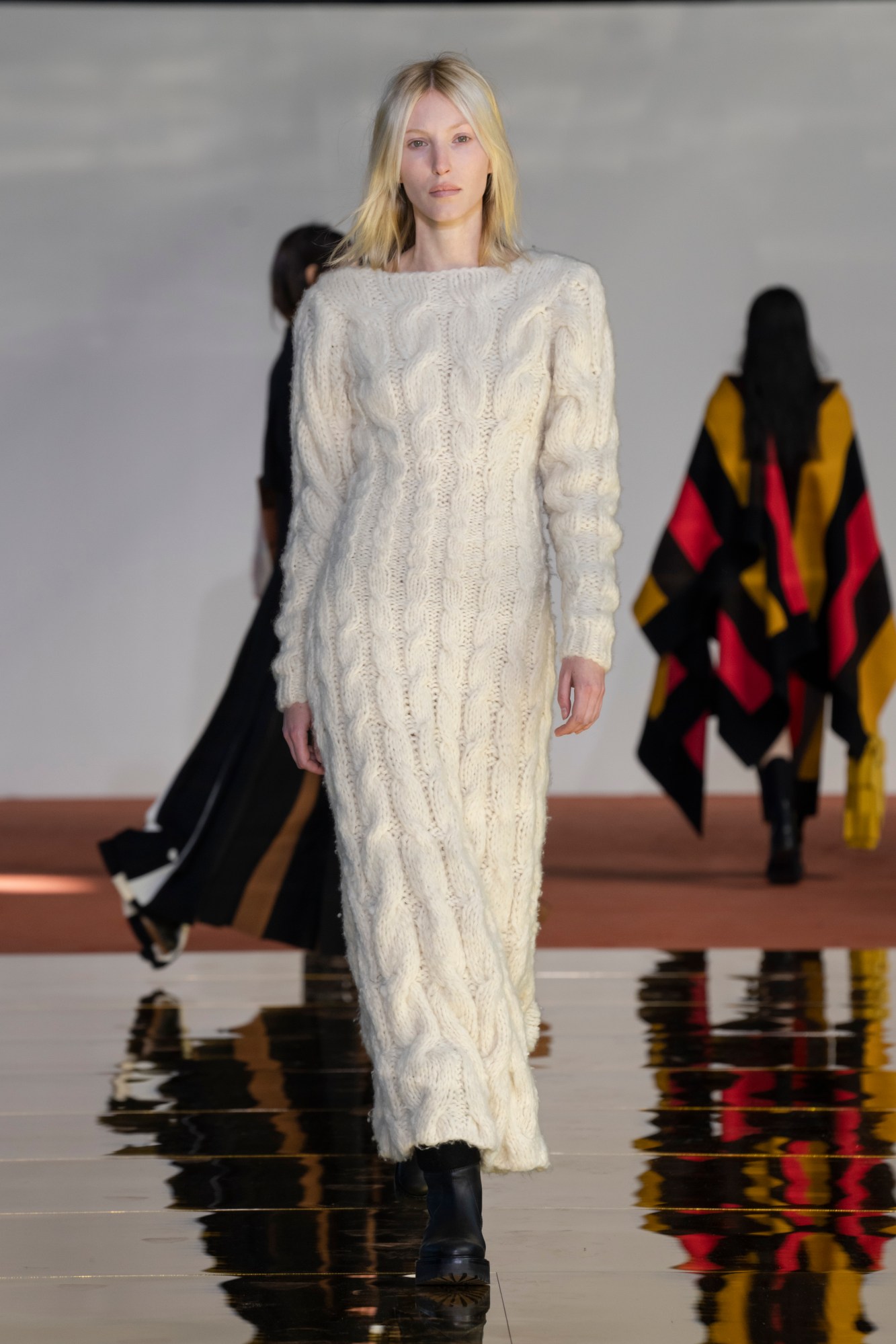
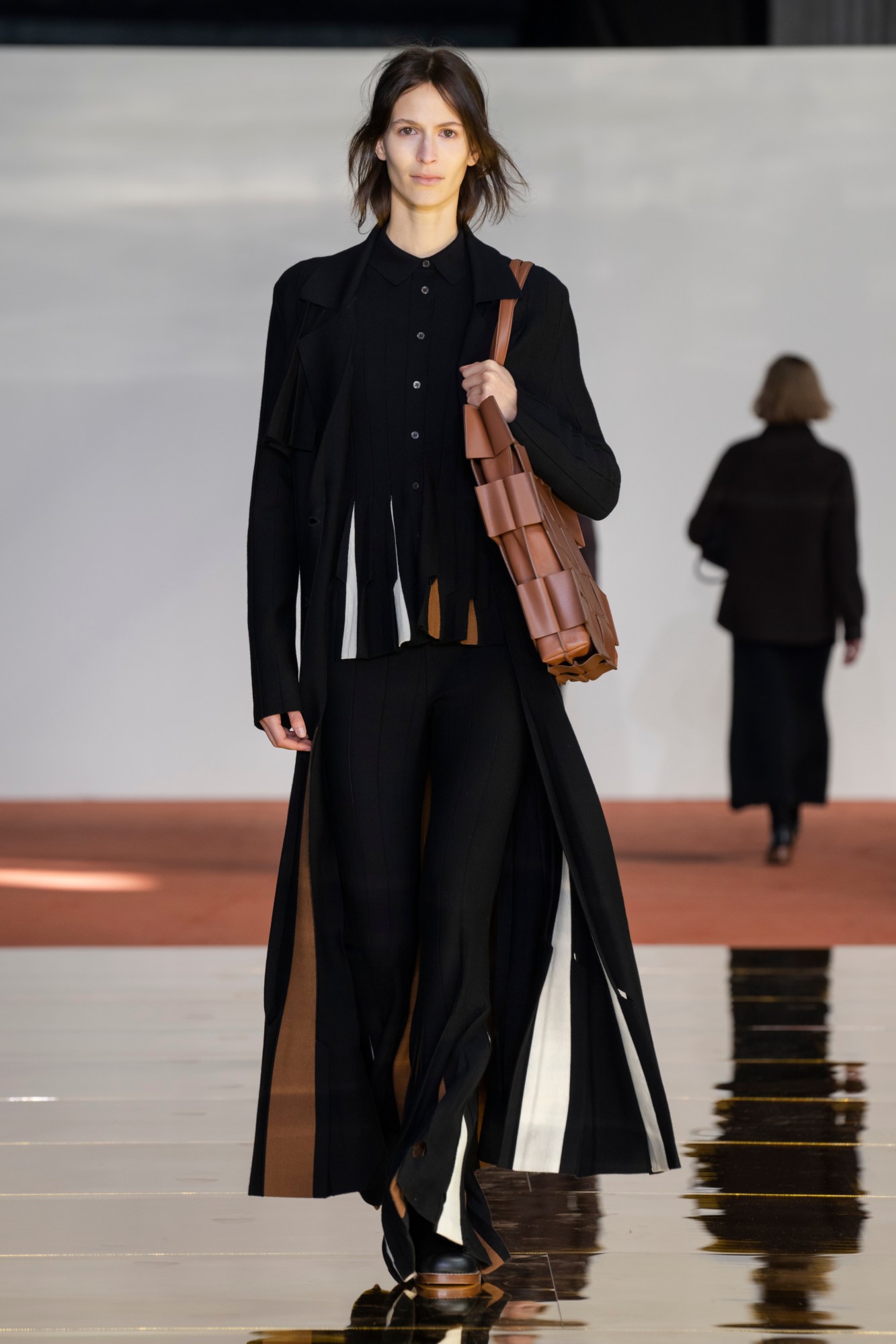
Gabriela Hearst
The setting of Gabriela Hearst’s show yesterday – a monumental warehouse in Brooklyn’s Naval Yard, fitted with a mirrored copper floor – was easily among the most imposing we’ve seen in New York so far. Grand a backdrop as it may have been, though, it ultimately served to bring the clean sobriety of the clothes on show into relief. The point of departure for Gabriela’s refined sartorial explorations was the work of Eileen Gray, the Irish designer and architect, and a pioneer of the Modern Movement, working before the likes of John Badovici and Le Corbusier.
Drawing inspiration from the clean-lined minimalism of Eileen’s tubular chrome furniture – which, it should be noted, she was the first of her contemporaries to create – Gabriela presented a collection anchored in the sharp-yet-subdued tailoring and sumptuous knits that she’s made a name for with her namesake label. A suit in a tawny wool flared gently at the hip, while another in a marigold yellow fell flush with the body. Gabriela’s honed leatherworking skills also shone through in jackets cut in dulcet suedes and wide front-pleated trousers came in the butteriest black leather. Elsewhere, Eileen Gray’s lacquered screens informed a swathe of intricate leather bags and coats – composed of interwoven bands and featuring subtle graphic cut-outs – each of which felt as investment-worthy as a piece of the late architect’s furniture. MS
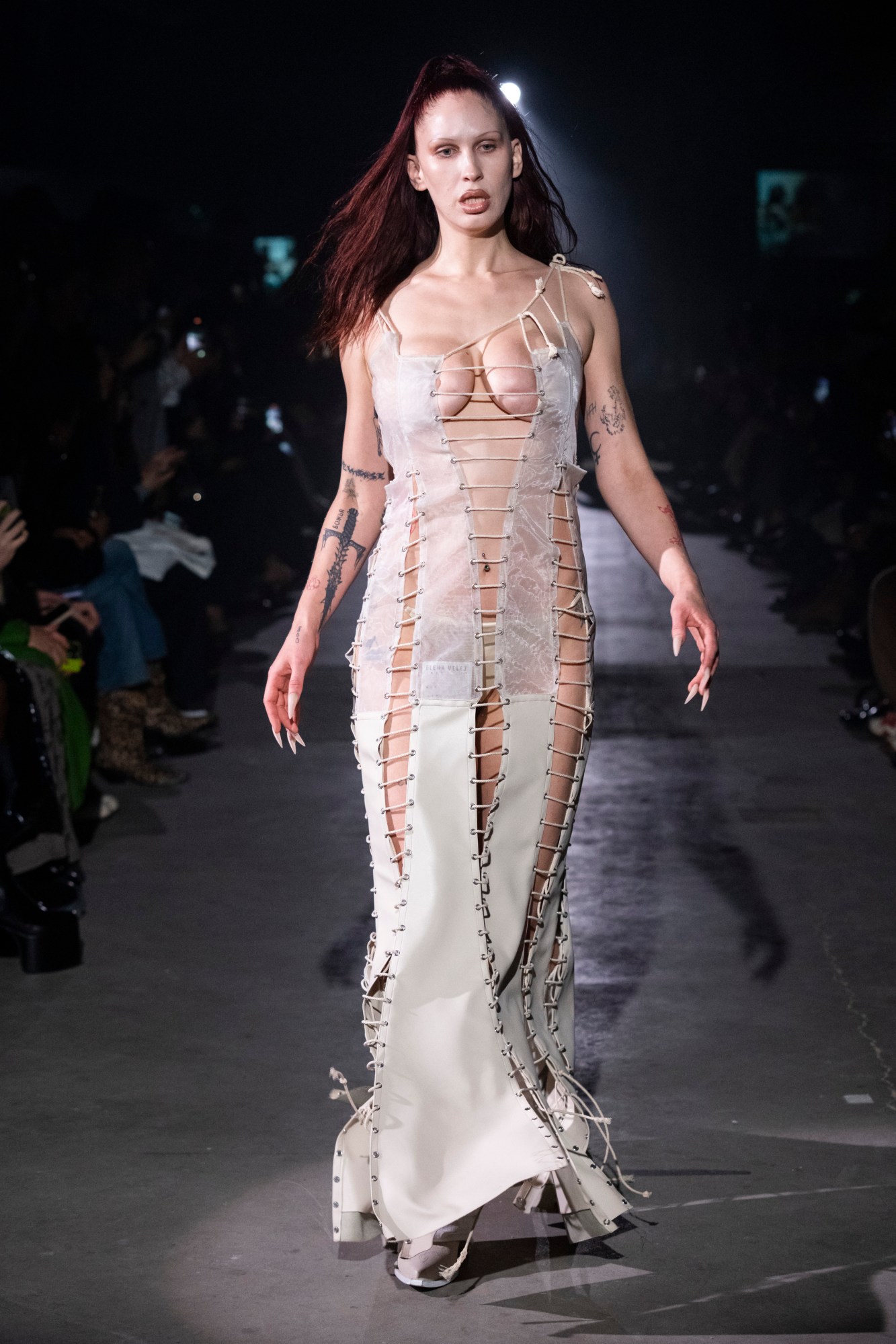
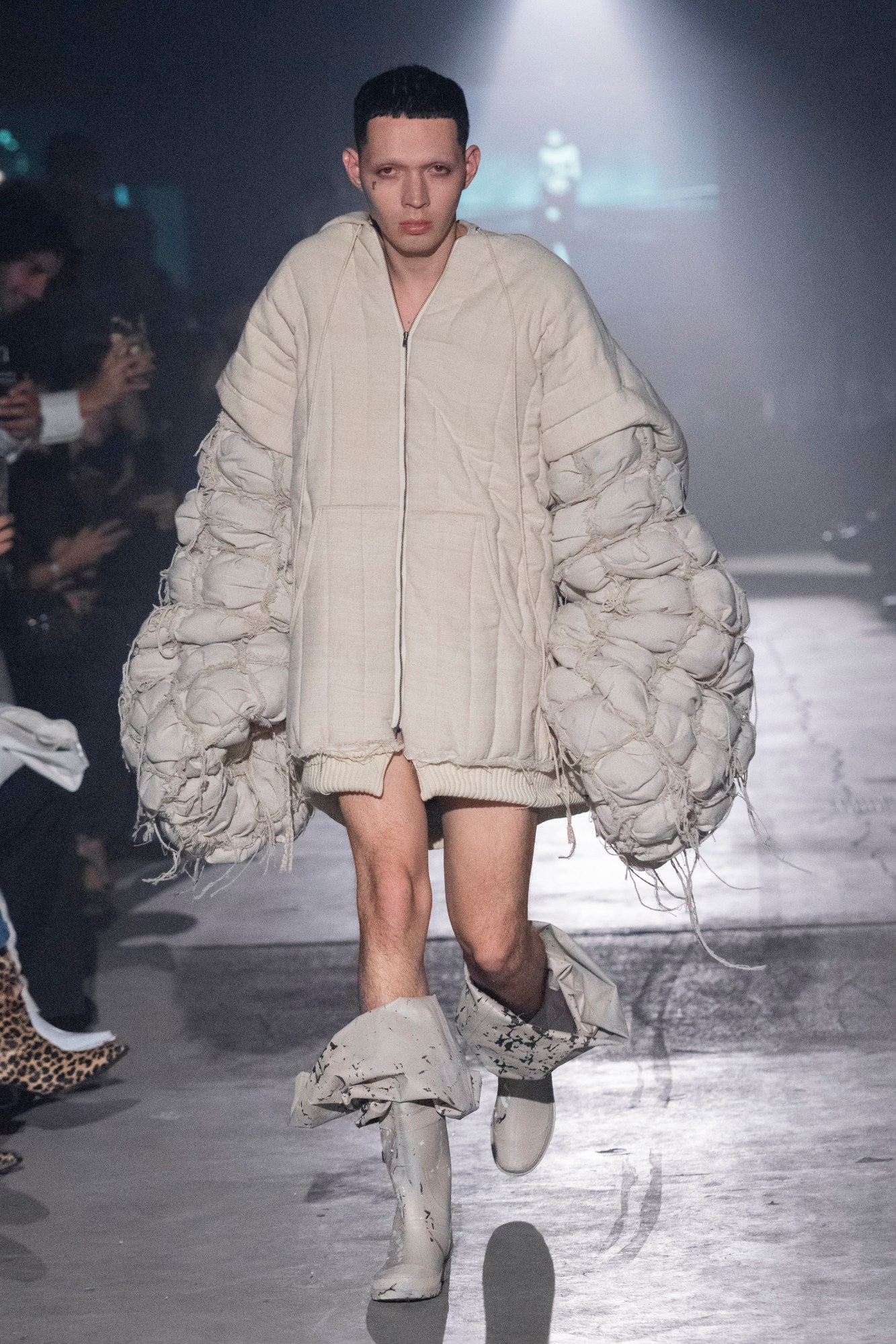
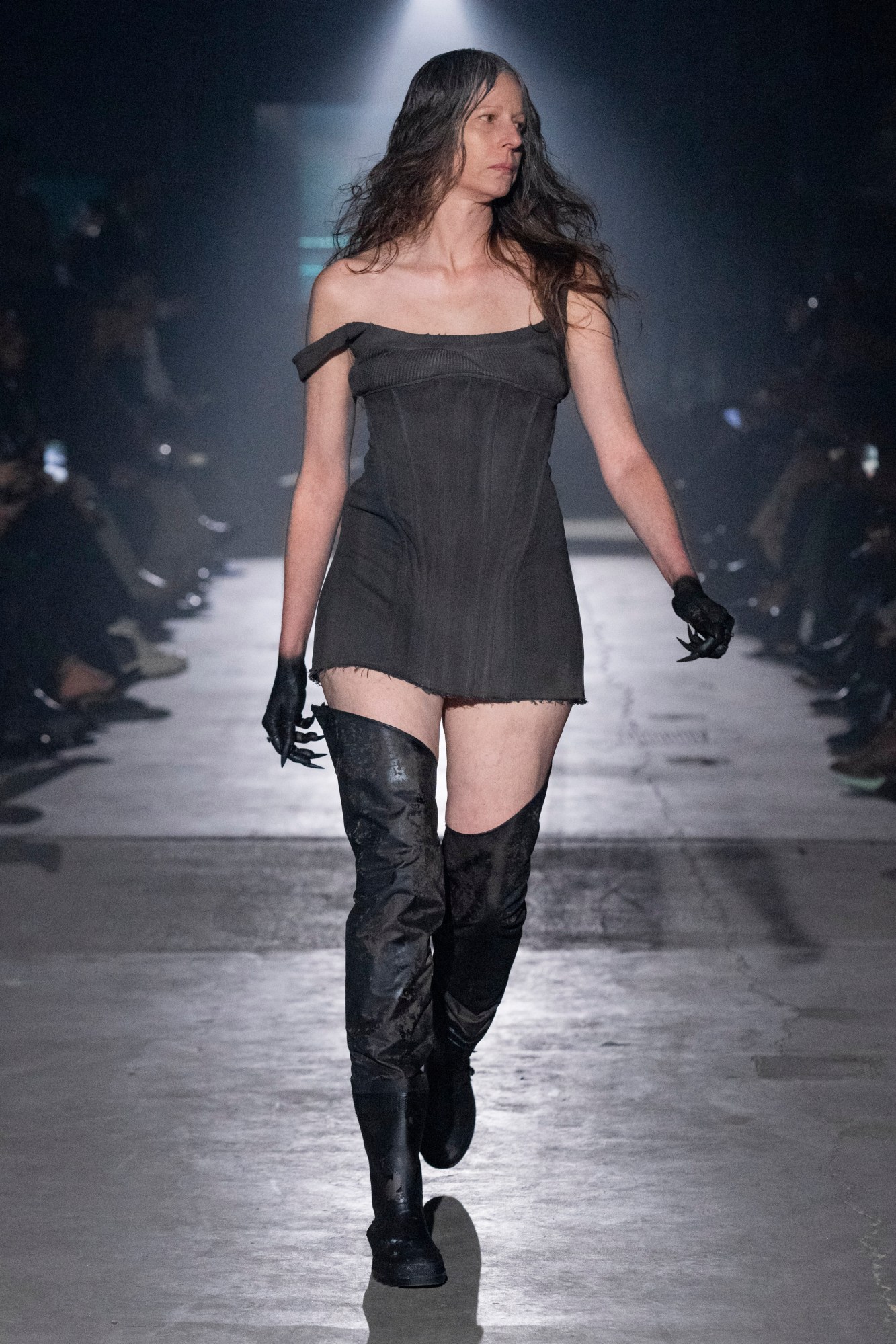
Elena Velez
Elena Velez presented her latest collection, YR003: HOWS MY DRIVING?, in a dimly-lit warehouse in Brooklyn: a film picturing models walking down barren highways in strappy, hooded garments, dodging car crashes; a ragtag band of vigilantes gearing up for battle in smudged makeup and scars set the mood. Then, Eartheater opened the show – twitching down the runway in a dress stitched up the centre, the sides, just about everywhere, with heavy duty cords and grommets that pressed into her skin. When paired with the mechanical, industrial noises that soundtracked the first few looks of the show, it was all a bit jarring, unsettlingly even, but that’s exactly how Elena intended it to be.
“Every collection is inspired by the tropes and the caricatures of bygone Americana, so we work a lot with wasteland heroines and women who are building a legacy in a place of impermanence,” she said after the show. “We’re looking a lot at prairie wives, lot lizards, truck culture, all of these things that are deemed unglamorous by cosmopolitan standards.”
Elena’s Midwestern heroines – for the uninitiated, she grew up in Milwaukee, Wisconsin, the daughter of a single mother, who was a ship captain on the Great Lakes – are dressed in canvas, cotton and linen dresses that drip off the shoulder, pooling at the body’s natural curves, raw hemmed corsets accentuated with mechanical leather gloves and boots, thick sailing knits and kinky ties, some even have their hands dipped in plaster or paint with an oil effect. There’s a sheer liquidious dress that oozes; the fabric treated to look like placental fluid. “I’m a mom and so the collection’s very inspired by matriarchy,” Elena says. “Dealing a lot with what that looks like as a woman, but then also as the infant coming to life.”
The last few looks in the collection see stereotypically feminine dress deconstructed, and rebuilt as armour – in the form of puffed up popcorn outerwear, a slashed utility gown reinforced with Milwaukee steel and a gauzy shrug, caressing the shoulders of her metal trophy-wielding, anti-pageant queen, in a way that feels equally as hard as it is soft. Sure, Elena is putting her unique Midwestern spin on it, but the spirit of the collection and the show are all fairly synonymous with the experience of being a woman, or femme-presenting person, in America today. Even stylist, Joe Van O, instructed models to walk down the runway as they’d imagine boys would, with absolutely zero awareness of being perceived. Despite the theatrics this created in an industrial setting, Elena Velez also succeeded in commercialising the destruction this season – creating more wearable garments than ever, easily fit for the sales rack. ND
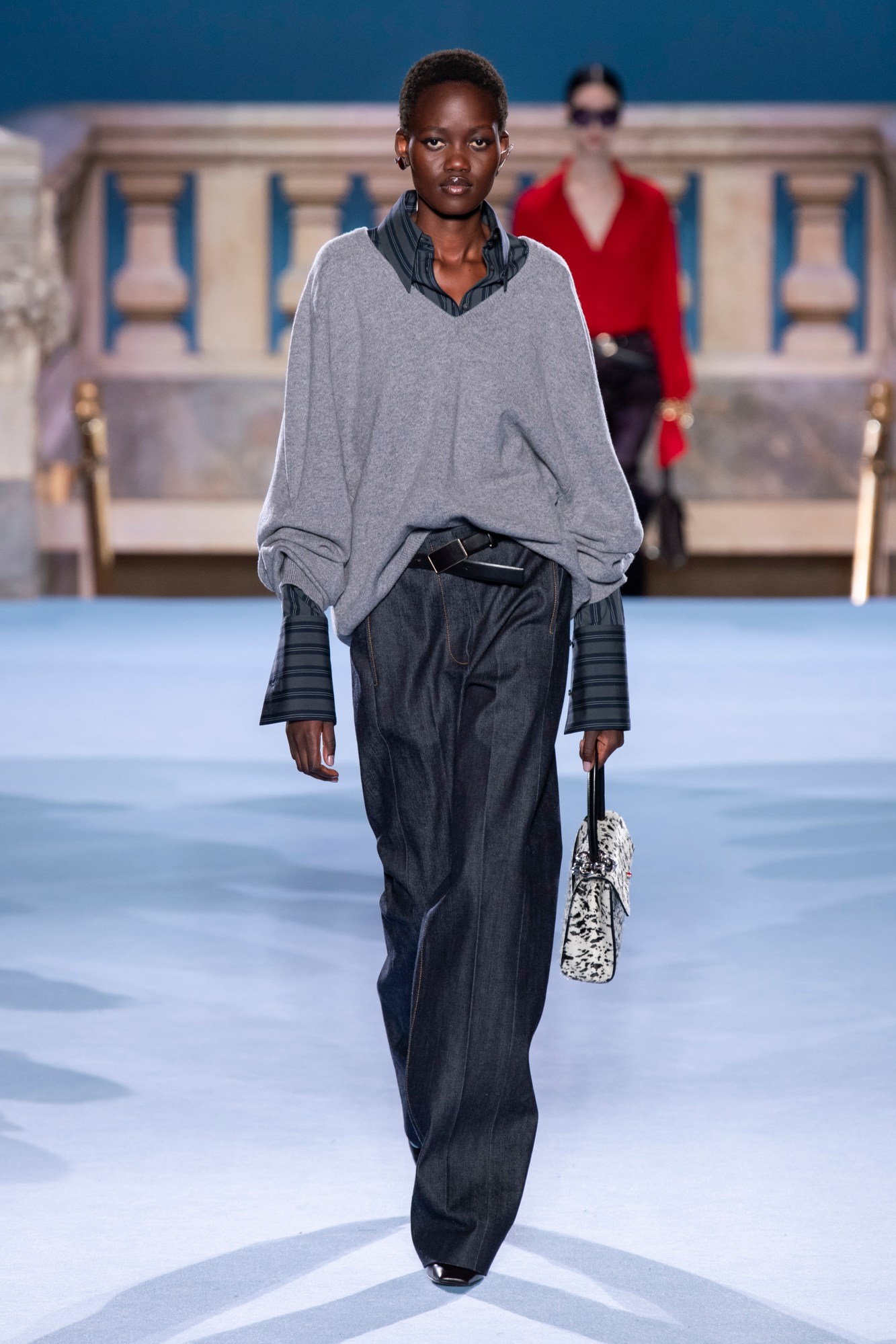
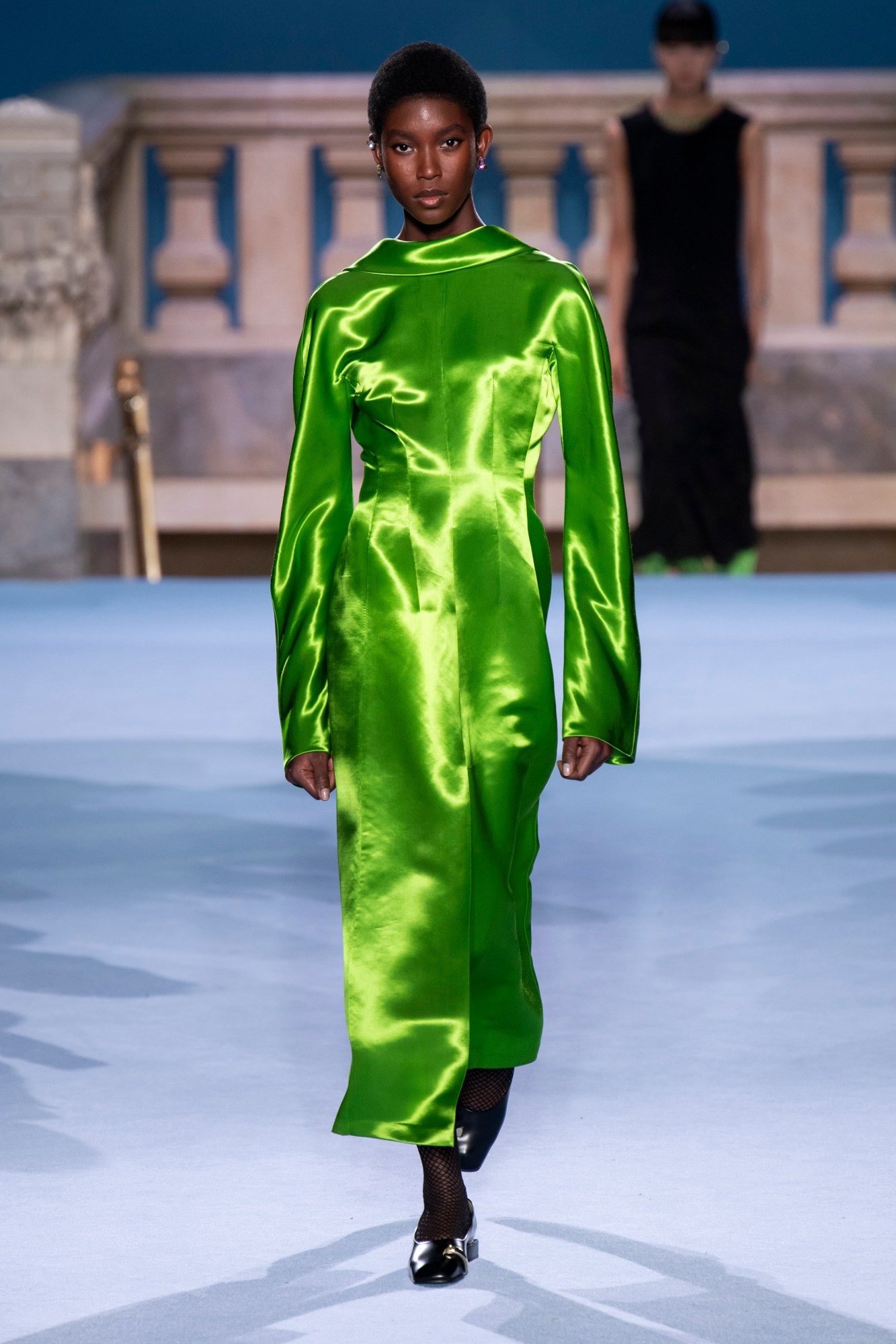

Tory Burch
Much has been said about a Tory Burch renaissance, whether due to new additions to the designer’s creative and corporate teams, or simply a more self-assured, post-pandemic approach to designing garments for the modern woman. However, no matter which camp you find yourself standing in – perhaps with a pair of the brand’s revamped, Bella Hadid-approved ballet flats on your feet – it’s hard to ignore Tory’s pared-back, slightly sexier collections of the last two seasons.
AW23 proved no different, opening with sharply twisted monochrome wrap skirts, safety-pinned at the hip, and clean, collared knits that seemed to be more aligned with Mrs. Prada than Hamptons-core. Of course, there were wardrobe staples on display at Emigrant Industrial Savings Bank Building last night, such as oversized trench coats, linen skirts and relaxed trousers, but a sense of coming undone was injected throughout: slim leather belts barely cinched, pleated skirts sitting askew and open “falling off” logo top-handle bags, the contents of which looked about to spill out onto the powder blue carpeted runway. On which, Irina Shayk and Emily Ratajkowski both made a convincing case for Tory Burch 2.0. ND
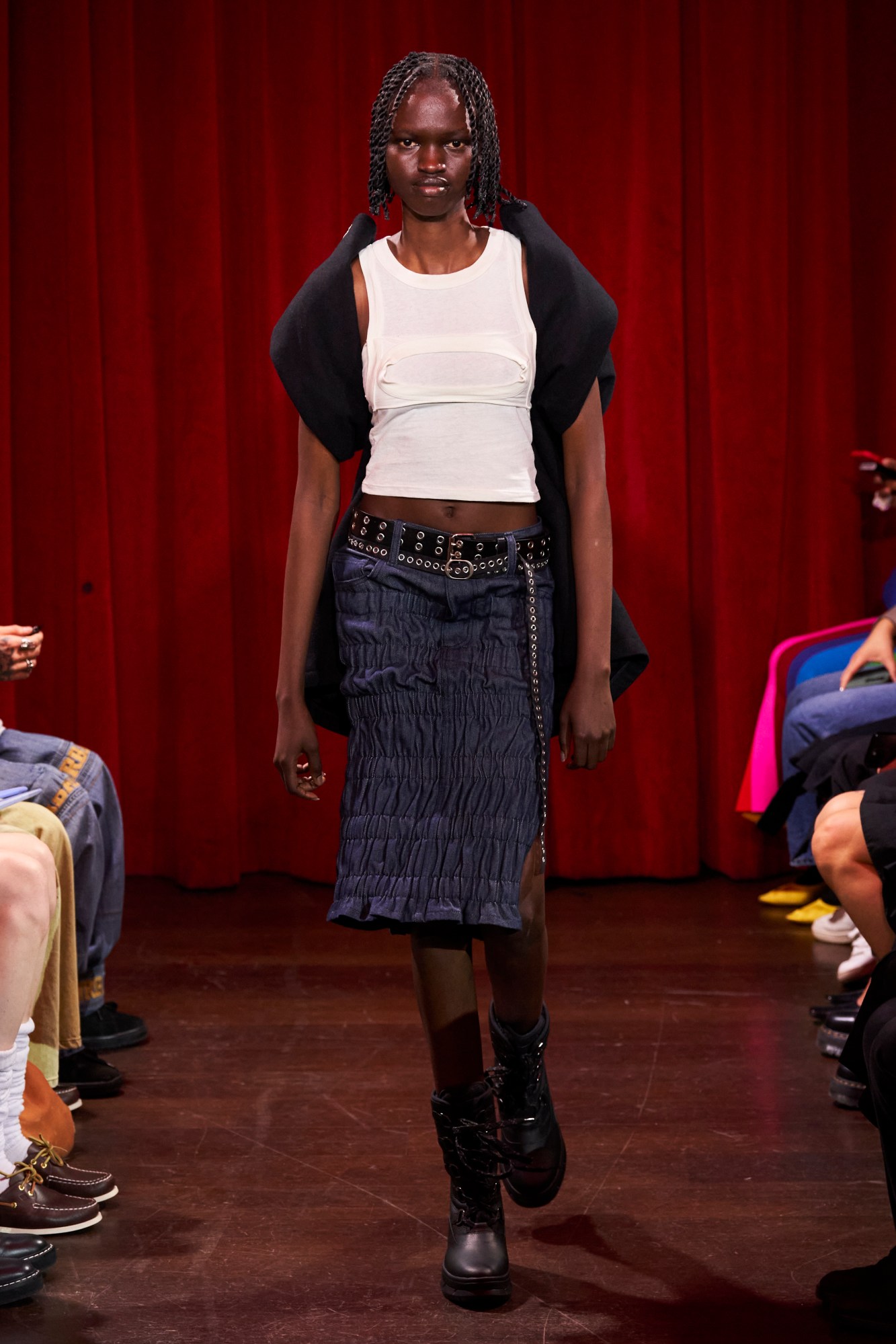
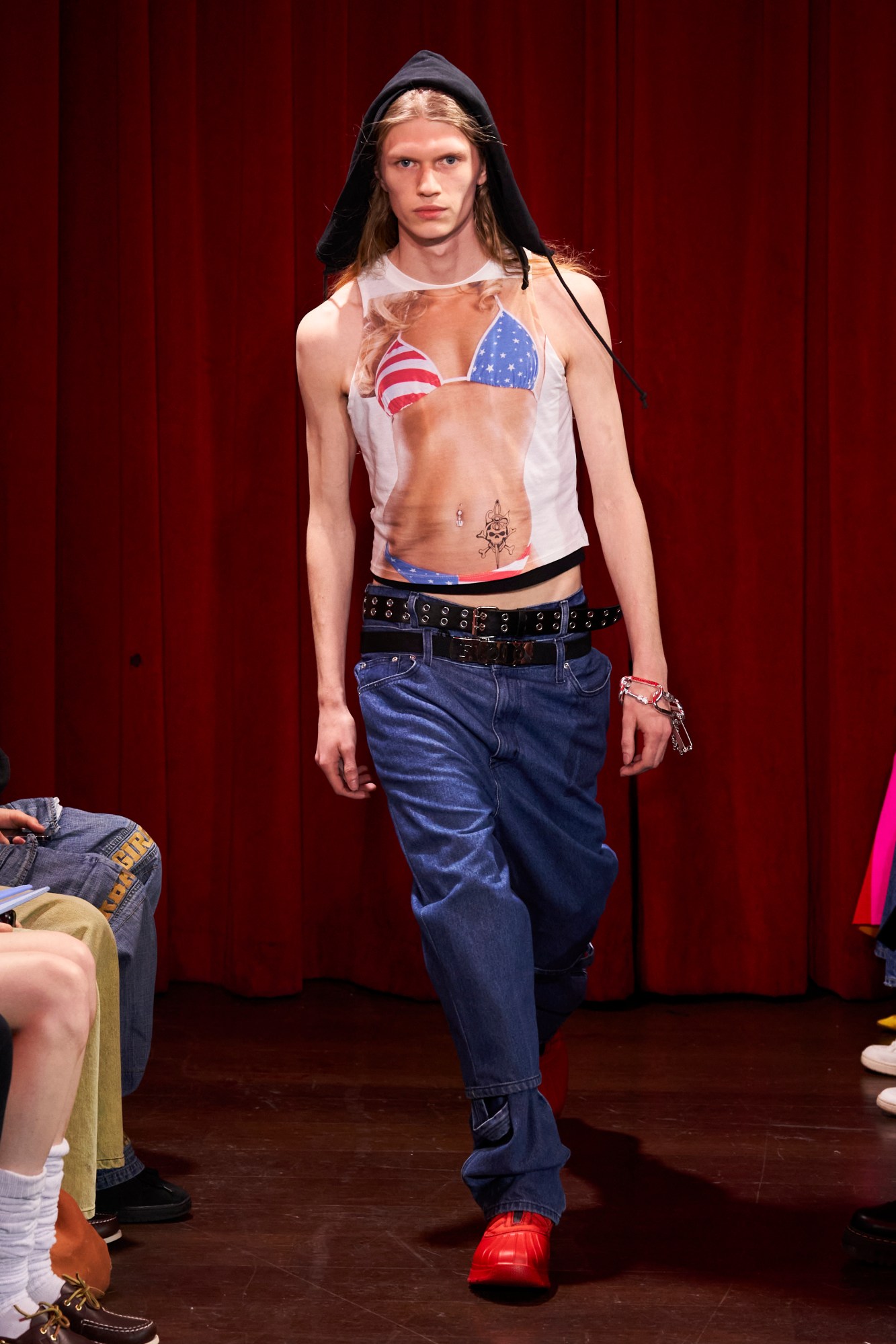
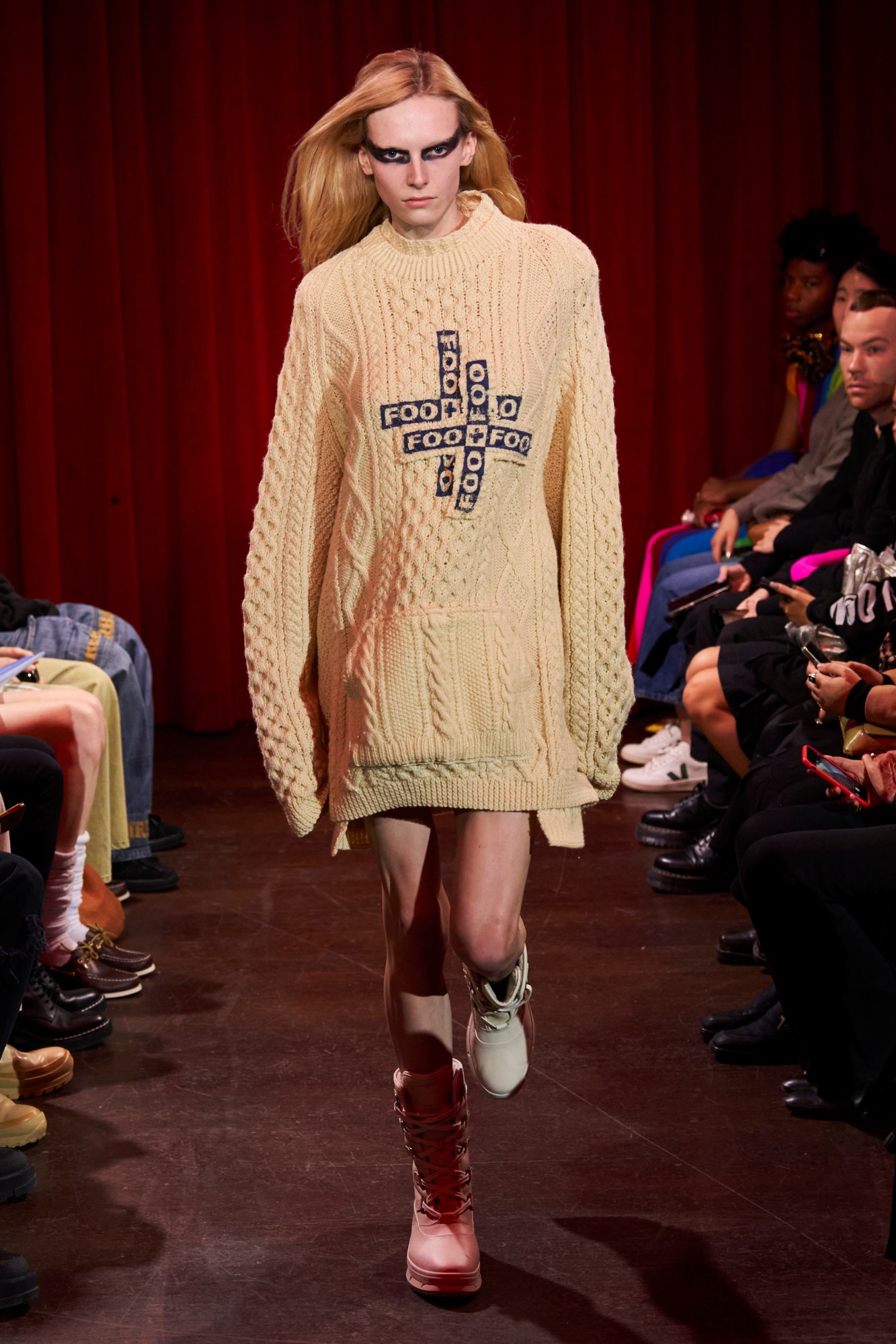
Foo and Foo
For Foo and Foo’s AW23 collection, Elizabeth Hilfiger drew on memories from her adolescence. Raised between New York City and Nantucket, she never felt fully at home in either place, thus this collection’s blend of preppy nautical wear and style cues you’d expect to see on kids hanging out in downtown New York or Los Angeles.
In keeping with the brand’s DNA of driving everyday basic shapes into experimental territories, there was a heavy emphasis on utilitarian pieces like cargo pants decorated with silver carabiniers, denim oversized work jackets, combat boots and early 00s emo-era grommet belts. Also in the mix were pleated schoolgirl skirts, striped vintage tees, chunky cable knit fisherman’s sweaters and tank tops emblazoned with trompe l’oeil prints created in collaboration with tattoo artist David Enth.
Staged at the Paradise Club at the Times Square EDITION, the show felt more like a function than a fashion show, with guests seated both in rows at the centre of the room and at round tables lining the perimeter. Models walked through the red-lit space to blaring techno at a breakneck speed so fast you had to pay close attention to catch their look — very much mirroring what it feels like to people watch at a crowded after-party. AT
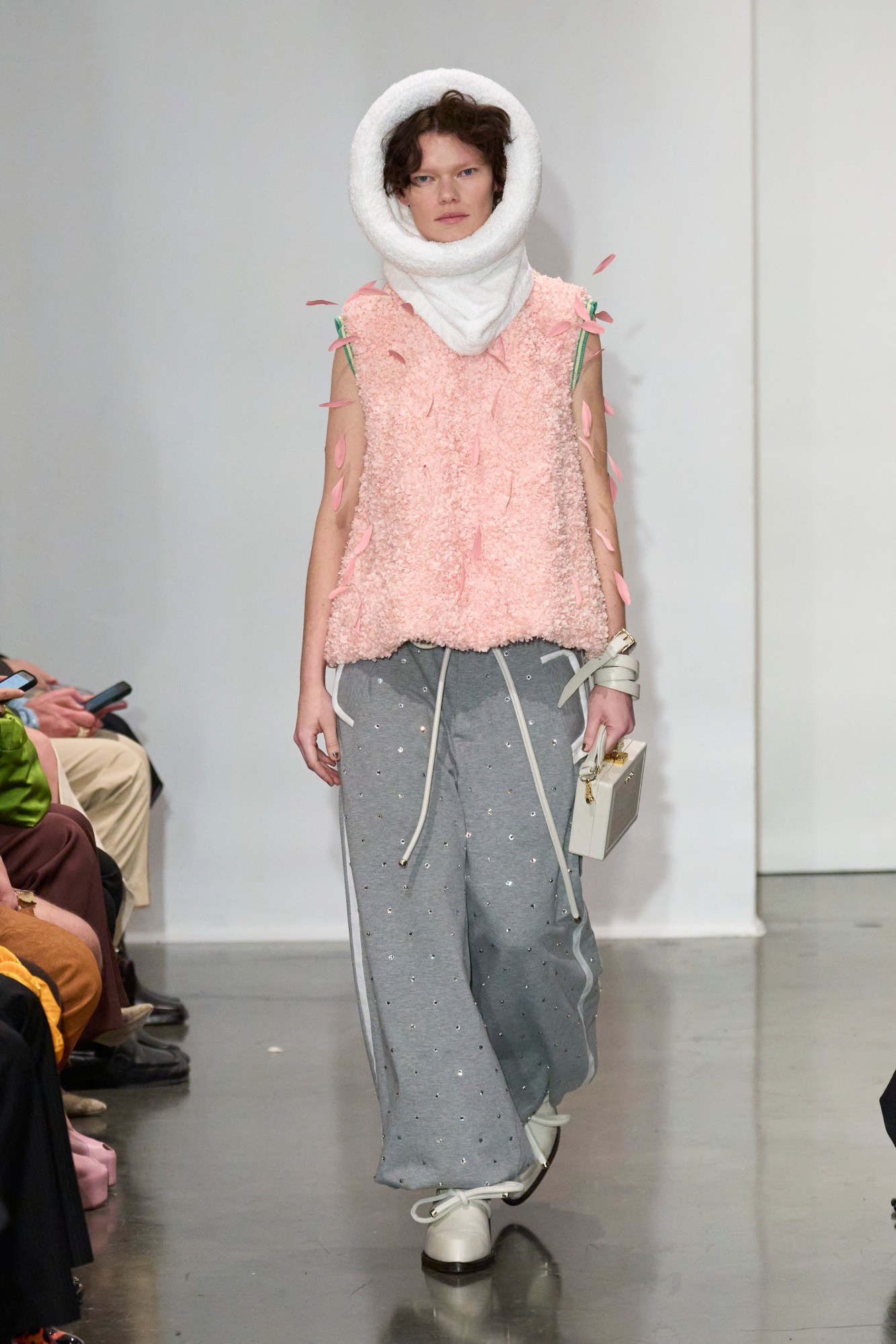

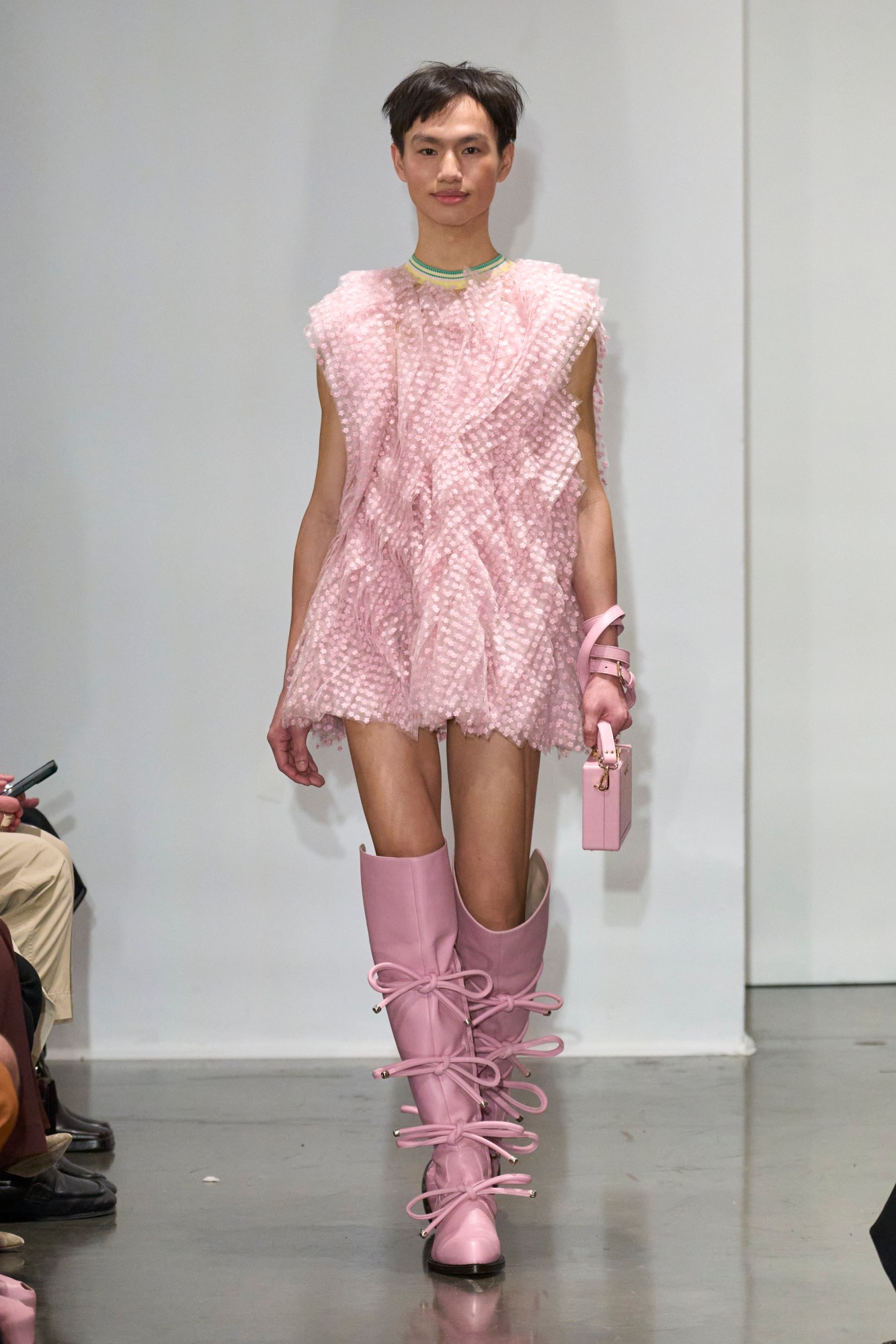
Palomo Spain
Fashion, famously, is an unrelenting industry – one in which designers are routinely expected to present original, thought-provoking, desirable collections every six months (with far less time than that to actually design and create them). The thing is, though, that good fashion – well, good anything for that matter – takes time. Looking at the collection that Palomo Spain presented yesterday – the first full collection that Alejandro Gómez Palomo has shown for his namesake label since SS22, and his first show in New York since SS19 – Alejandro has made the most of just that, resulting in what felt like his most accomplished, believable collection to date.
Titled ‘The Closet’, it naturally invited reflections on the transformative journeys that any queer-identifying person goes through in coming to terms with their identities. A sense of the liberatory self-expansion that comes with coming out made itself felt in the breadth of tropes explored – and in how they were playfully subverted. The campiness of the lilac coque feathers that bloomed from a cropped boxy shift dress in snow white teddy fleece was counterposed by sporty tricolour ribbed collar; elsewhere jockish cream ribbed jerseys were shrunken, paired with hulking sweatpants constructed from stiff panels of navy faux fur, and varsity bombers came in iridescent vinyl, worn over trailing gowns in the striped poplin you’d expect of a finance bro’s shirt. Blue denim jeans came covered in sequins, and the lothario lust of grey sweatpants was tempered by the cutesy crystals they were spangled with.
In fitting Palomo Spain fashion, there was an abundance of high theatricality, too, in matelassé cotton coats with cartoonishly overblown lapels, pillow hats, liquid jersey gowns, and cascades of faux fur and frou frou frills, but what perhaps made this such a successful proposal tied into another layer of meaning couched in the collection’s title. This was a body of work from a designer that feels confident enough in his aesthetic identity to be uncompromising in expressing its identity, but also mature enough to realise that this business is about making clothes that people can wear beyond the fantasy world they’re products of. Here, Palomo toned down the pantomime costumery that has marked much of his previous work, resulting in garments that a much broader audience will now be eyeing up for their closets. MS
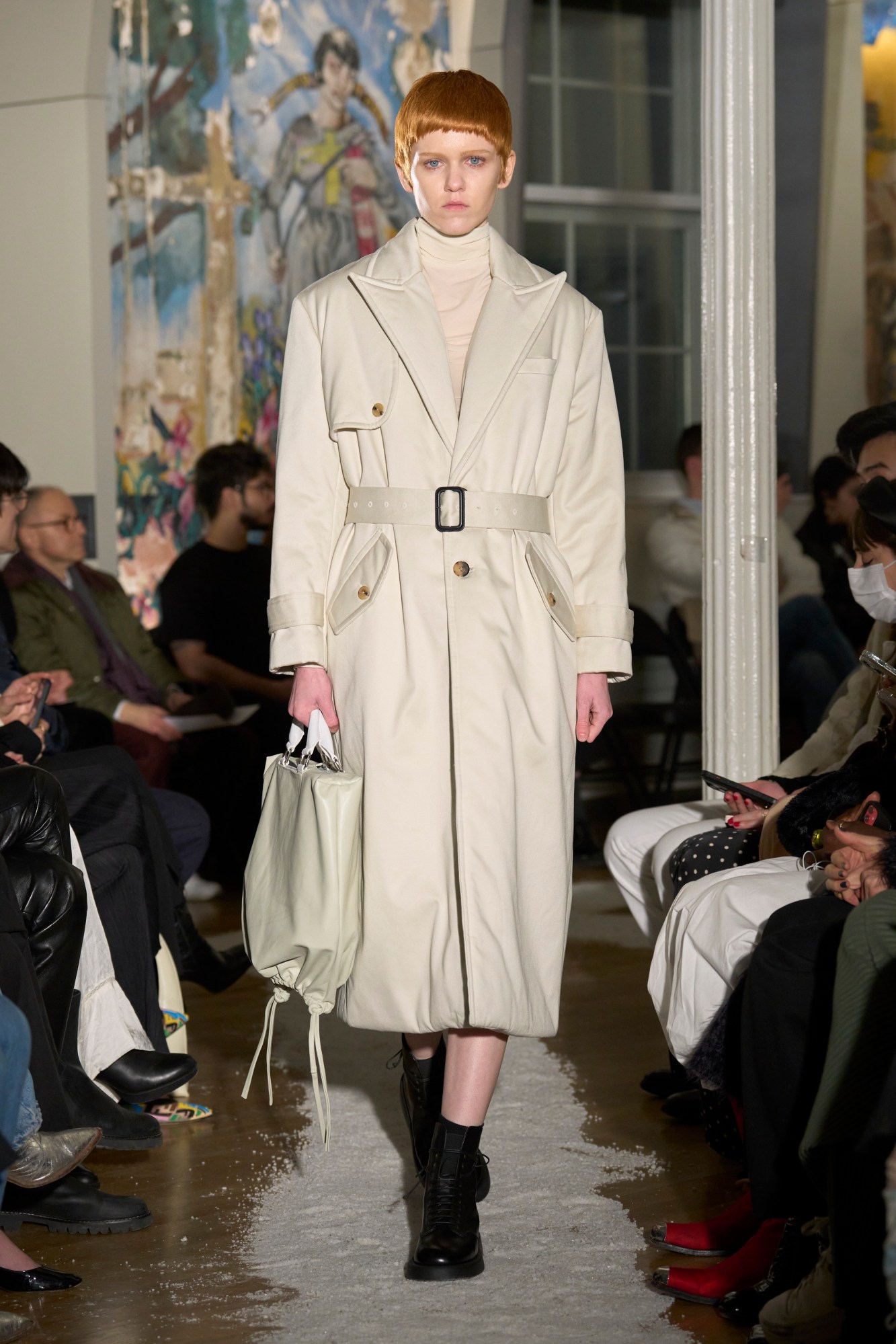

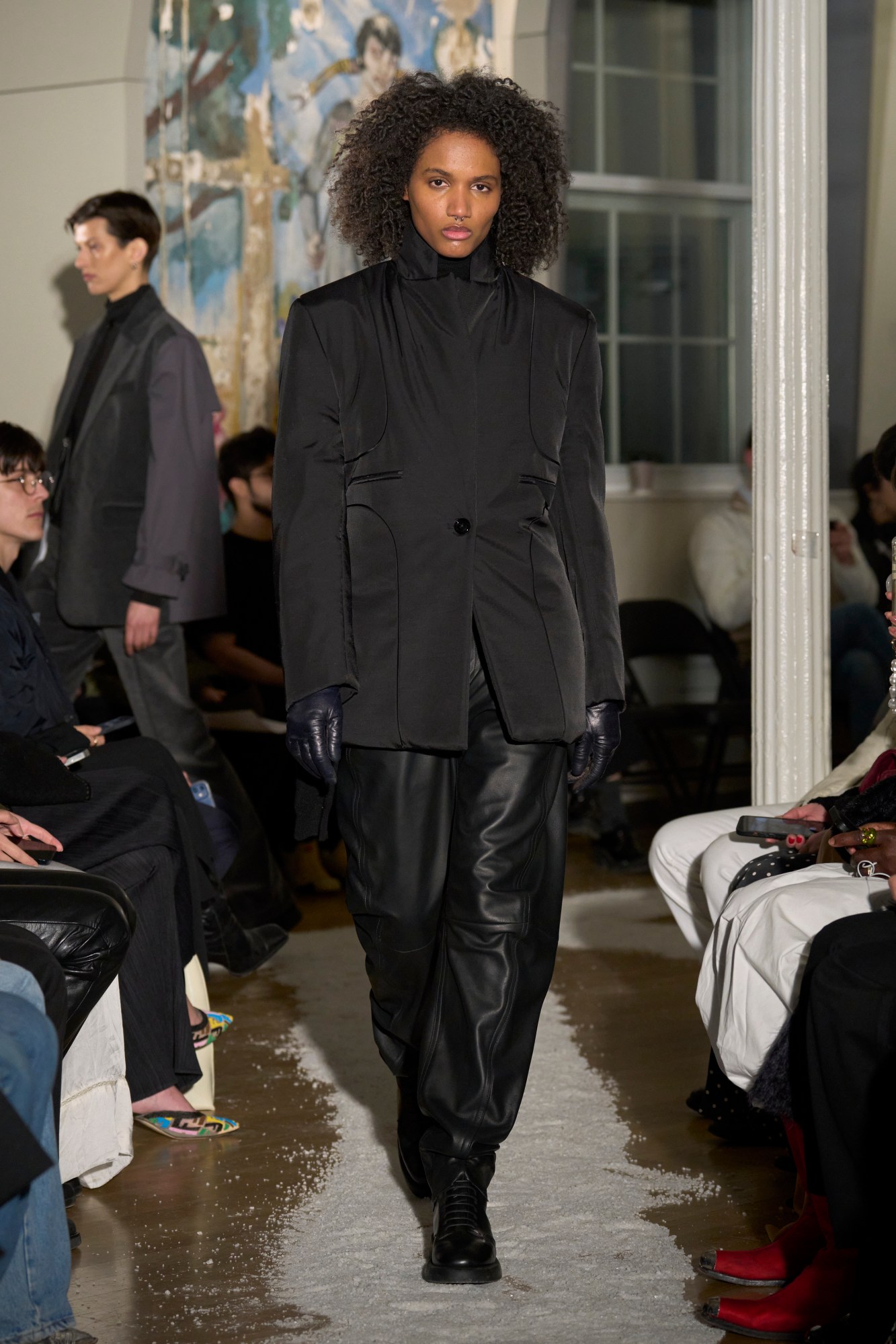
A—Company
Since founding A—Company in 2018, Sara Lopez has approached her work for the label less like a typical fashion designer — driven by the desire to create work that converts the cultural zeitgeist into sellable products — and more like a cultural theorist, using fabrics and garment construction methods to articulate nuances of contemporary identity. It’s an approach that, in many cases, aligns her with the longstanding New York tradition of fashion-art practitioners – think: Bernadette Corporation, Imitation of Christ, CFGNY – who saw fashion as a communicative means rather than as an end goal in and itself; who treated clothes as ciphers for ideas, rather than as things to be produced for people out in the world to actually wear.
That is, however, the key distinction with what Sara does. While imbued with a conceptual rigour – often meditations on queerness, and what, fundamentally, constitutes a ‘queer’ aesthetic gesture – that doesn’t overshadow the intelligence and consideration invested in the design of the clothes, which is what, ultimately, makes them so goddamn desirable. The collection she presented last night at an LGBTQ+ community centre in the West Village, for example, was a reflection on tailoring – specifically that the quality of a tailored garment is to be assessed by the details you can’t see; that a well-made jacket, for example, is one you could wear inside out. What she delivered was a concise series of irreverent riffs on the codes her chosen genre: a trenchcoat was given slanting pockets and exaggerated, tuxedo-style peak lapels, and the shawl lapels of an oversized chocolate waistcoat were doubled, flapping gently with the model’s step. In two standout felted jackets, the sleeveheads were pulled in so far that the sleeve essentially emerged from the breast panel. And elsewhere, tailoring’s fundamental materials were reimagined beyond their typical contexts, with shiny lining fabrics falling into graceful column dresses, vests and skirts, and bolts of tailoring wool insouciantly draped as shawls.
As stunning as that all sounds, the message at the heart of it is one that takes a little deciphering – and is ultimately up for interpretation and debate, as any work with critical integrity is. For me, though, what gives these clothes their power is their subtlety – rather than lean into outré or obvious notions of ‘queer fashion’, they embody an ethos of refashioning and reappropriating established aesthetic codes; of using normative sartorial vocabularies (here, tailoring) to articulate – and, in many respects, create – new facets of identity. While to many, putting a peak lapel on a trench coat and sending it down a runway may not seem like an especially bold move, read in the context of queer cultural history, it follows in a lineage of gestures that have profoundly shaped how we think of ourselves, and who we are. MS


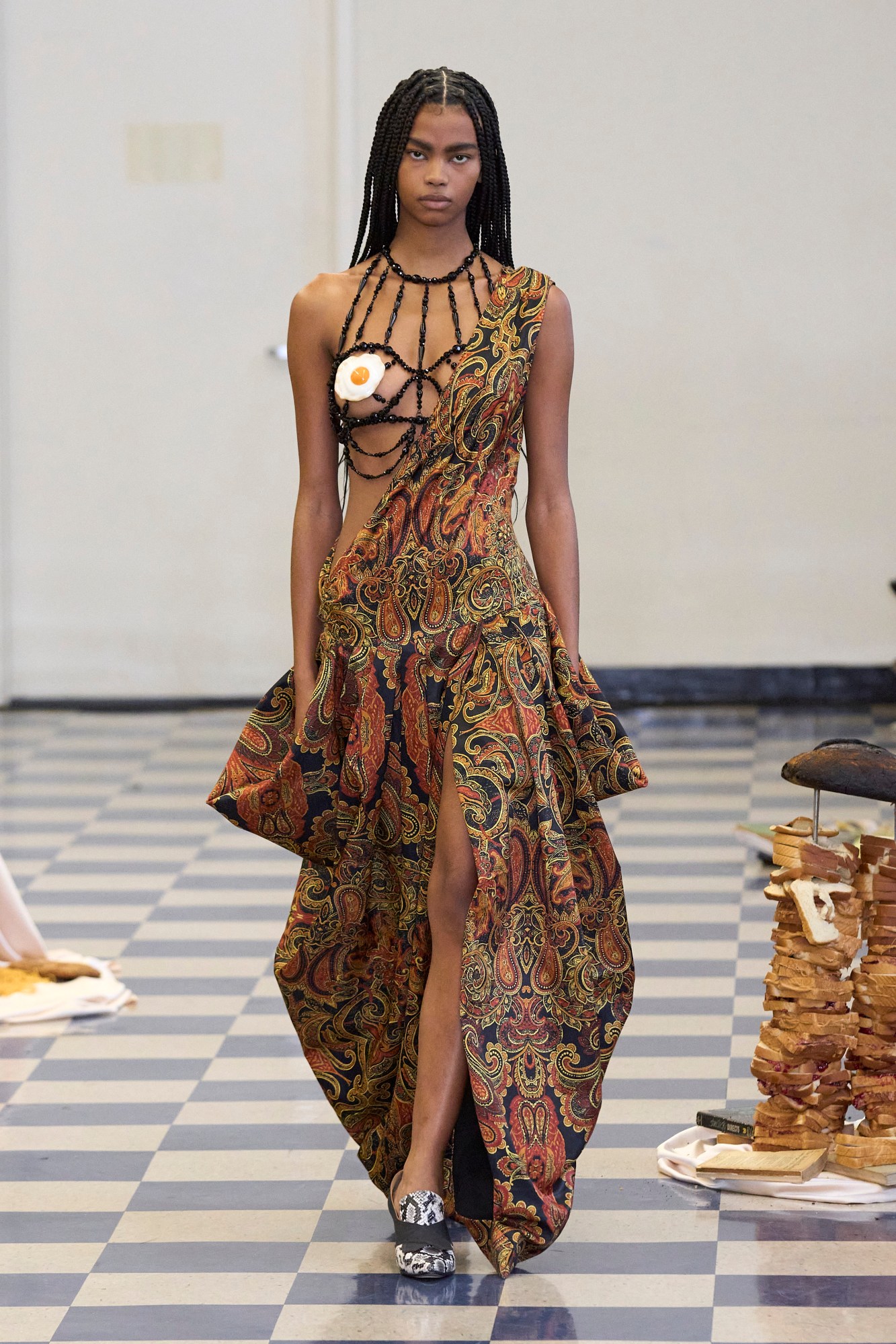
Puppets & Puppets
In the days leading up to the Puppets & Puppets AW23 show, designer Carly Mark teased a few of her now-signature, conversation-starting accessories on Instagram: a black leather shoulder bag with an old school phone receiver as a handle; a pair of witchy, moiré heels with two runny, sunny side up eggs at the toe — harkening back to her SS20 collection inspired by, among many other things, Russian Fabergé eggs and American Psycho; a red, furry take on her resin chocolate chip cookie bag. “Ring, ring- It’s called a pre-show leak people!” she wrote.
As she’s proven over the last few seasons, Carly Mark is a mad genius. Though her label, Puppets & Puppets, started as more of an art project slash fashion experiment, the way she’s managed to stay true to her niche vision while editing down for commercial viability is pure evil. This season, Carly sent a sheer black patterned evening gown down the runway, overlaid with a beaded bustier — red roses at the nipples; a series of well-tailored suits; 80s snake print separates in the form of one pointed lapel coat, high waisted biker babe trousers cut out at the hips, and one zip-up bustier catsuit; plus a sheer panelled dress and wool overcoat that felt very lady Dracula. Inspired by David Cronenberg’s 1988 psychological horror film Dead Ringers, there was noticeably a lot of blood red on the runway – in bulbous sequin dresses, taped up Margiela-inspired fuzzy coats, rose embellished bags and shoes, and in the graphic pieces, printed with Gaspare Traversi’s painting “The Operation” (1783), which features a man screaming out in pain mid 16th century surgery.
Set in a blue and white chequered hall at the Dinkins Manhattan Municipal Building, where Carly had lined the space with numerous food sculptures – a peanut butter and jelly sandwich tower, artfully-displayed dirty dishes, spaghetti spilling out onto the floor, and even a cookie bag cake, graciously cut into by Tove Lo, the show was an unconventionally sexy exploration into the future of surreal fashion. Hello operator, call us dramatic, but we’re still thinking about it. ND
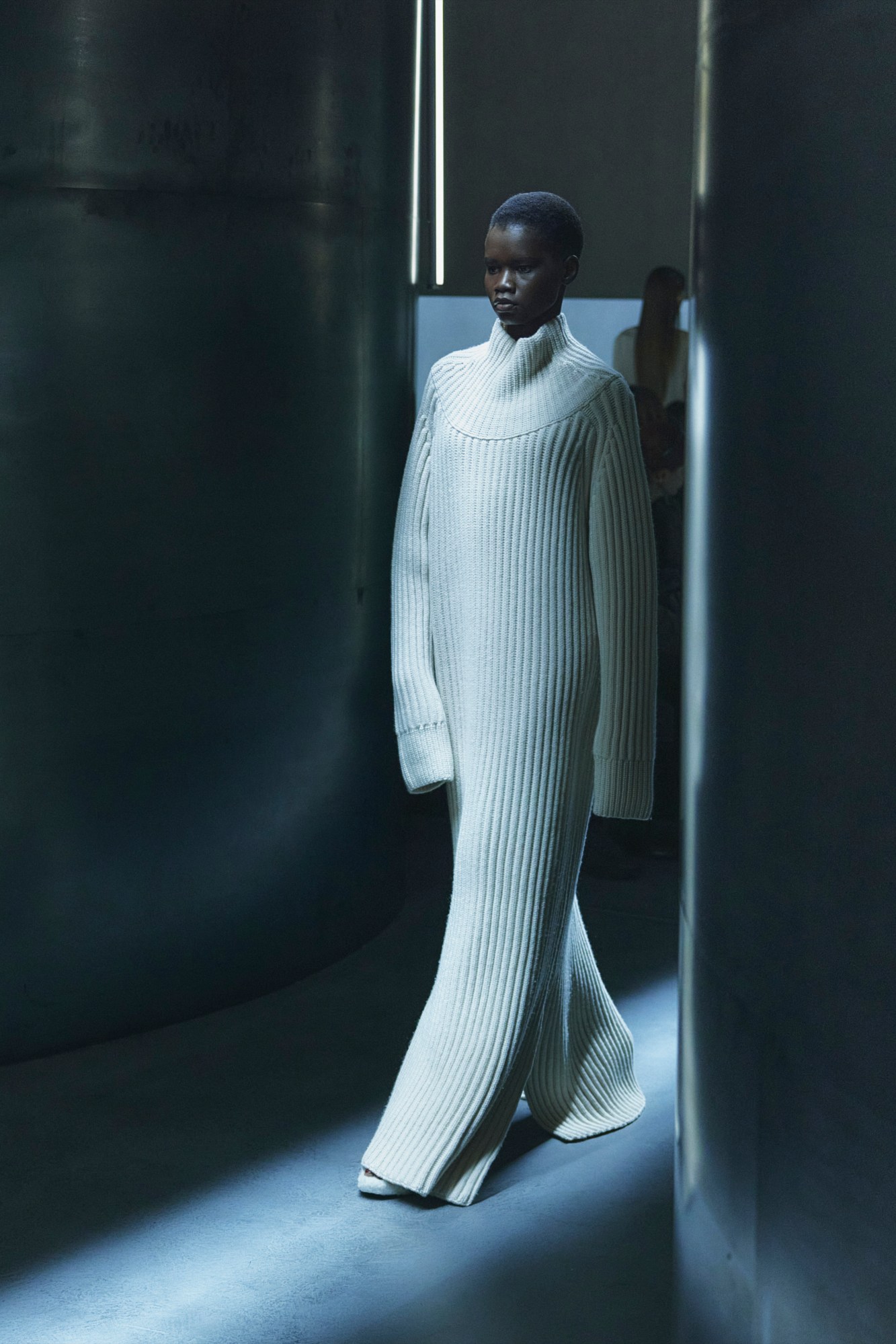
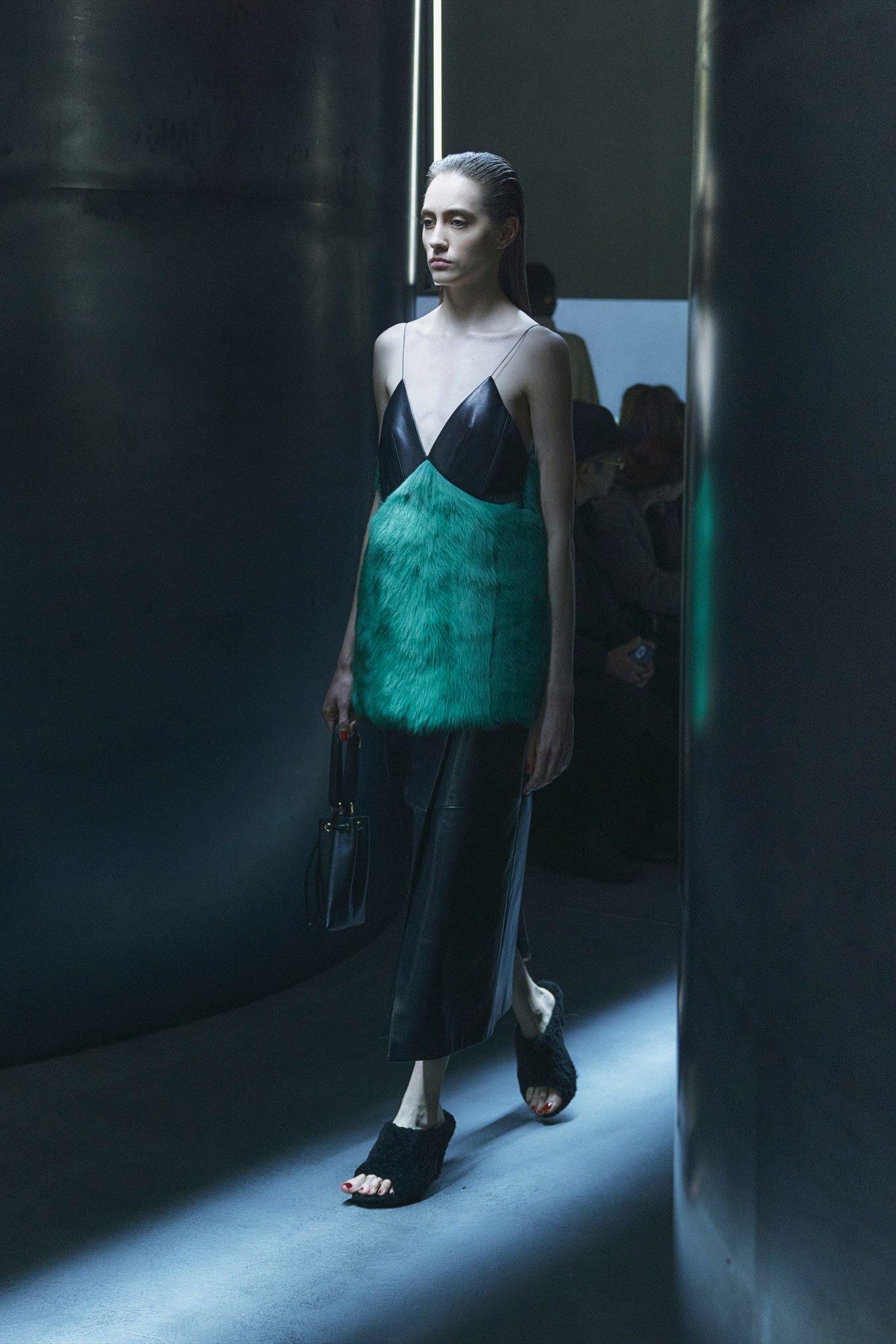
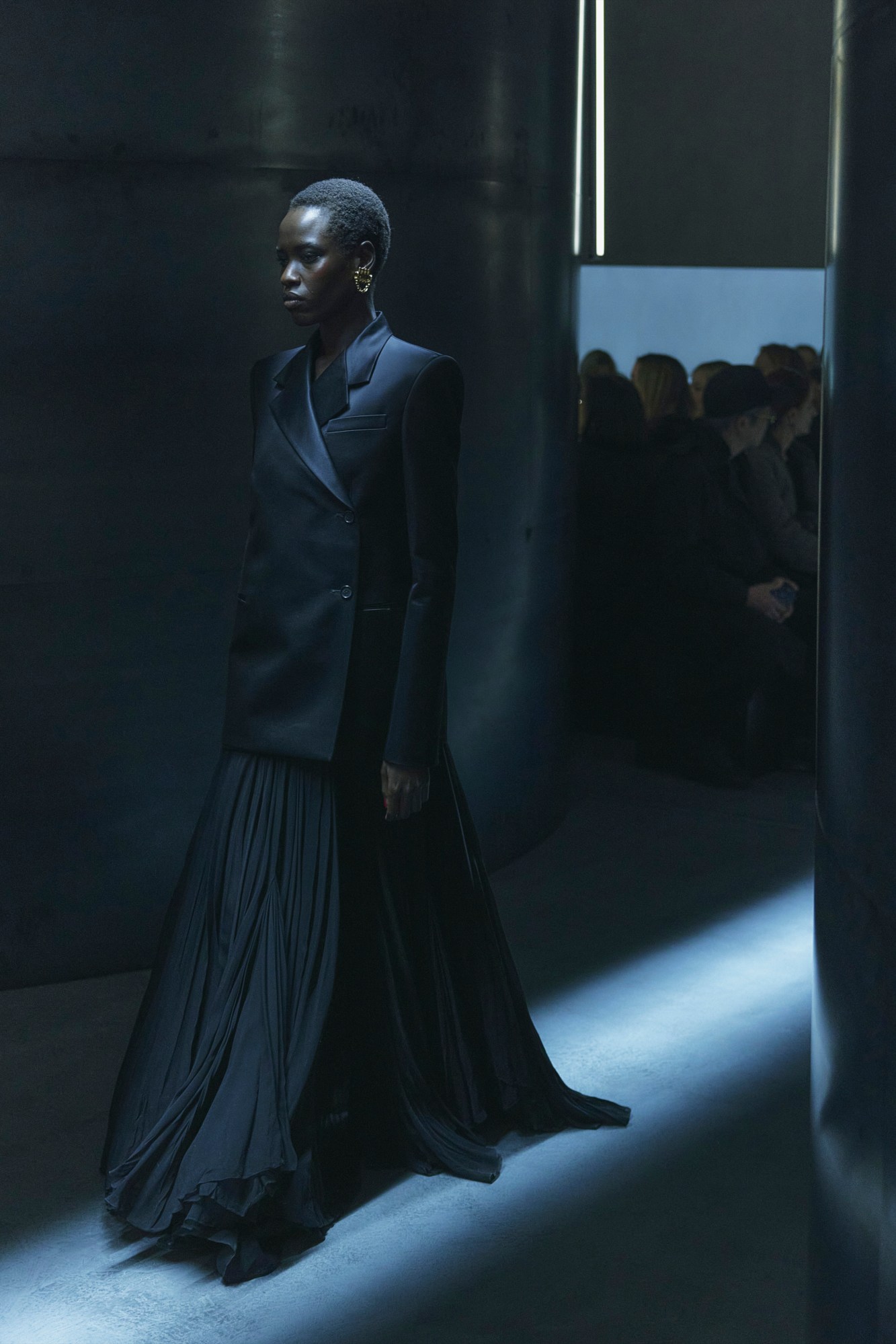
Khaite
Off the back of the recent, notable restrained AW23 menswear shows, murmurs around the latest in fashion’s unrelenting cycle of buzzy microtrends began: ‘recessioncore’. The term’s pretty self-explanatory, but, essentially, it refers to fashion’s well-attested proclivity for relative sobriety during socioeconomic bust times – think the swell in hearty Old Navy Americana in the wake of 9/11, or the dominance of a subdued, intellectual minimalism – singlehandedly brokered by Phoebe Philo’s tenure at Céline – in the wake of the 2008 Wall Street crash. As we stand on the cusp of what analysts are predicting to be one of the most severe periods of economic downturn in living memory, it seems like we’re seeing something similar, with designers forgoing high-minded concepts and fantastical yarns in favour of creating rigorous, wearable clothing – garments intended to be worn here in the real world, rather than as tokens from imagined realms.
Leading the charge in this respect is Khaite, a label that, in just seven years, has risen from a plucky upstart to one of New York’s must-see shows, garnering a cult following for its exquisite, elevated essentials. That was what made up the bulk of last night’s lineup. A square-shouldered great coat in polar white shearling came with contrast pockets in supple black calfskin, and a complementing number in stiff grey Melton wool was sculptural in its construction, elegantly swooping in at the waist to accentuate the contours of the wearer beneath. A sensibility for the importance of a fabric’s weight came through strong in the shirting, where the generous fit was counterposed by the crispness of the diaphanous organdies they were cut from, holding their shape – elsewhere, a floor-length dress in hefty écru ribbed knit communicated its reassuring weight, the way it would lavishly embrace your body, through sight alone. Some less monastic moments came through with glistening belt buckles, embellished leather bags, panels of verdant green shearling – most notable in a hulking pair of yeti pants and spliced with buttery calfskin on a spaghetti strapped A-line camisole – but the overall tone was one of exacting, restrained refinement. Clothes that quietly yet confidently imply their luxury status, but that easily translate to – and that even subtly enhance – the most ordinary of settings. MS
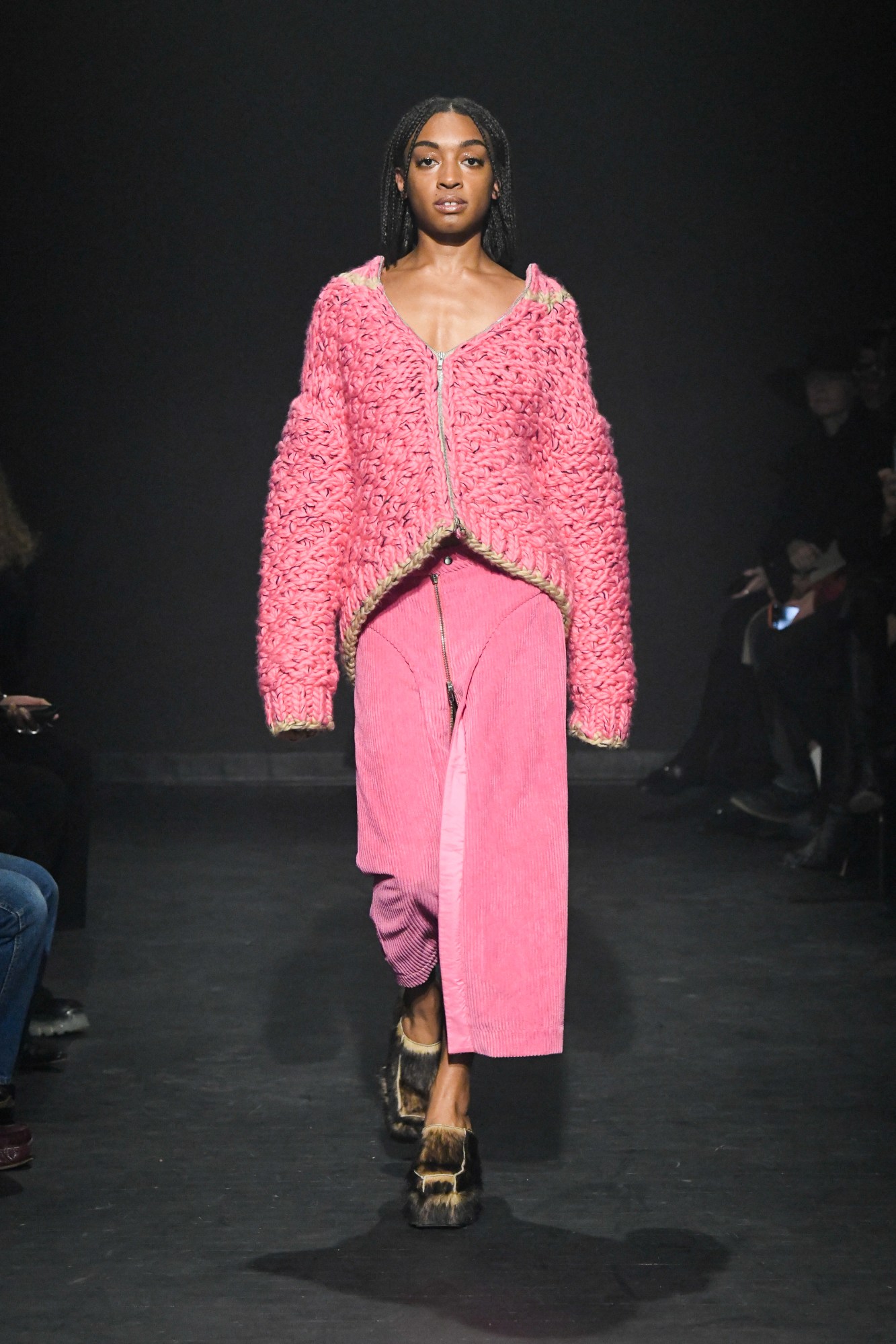

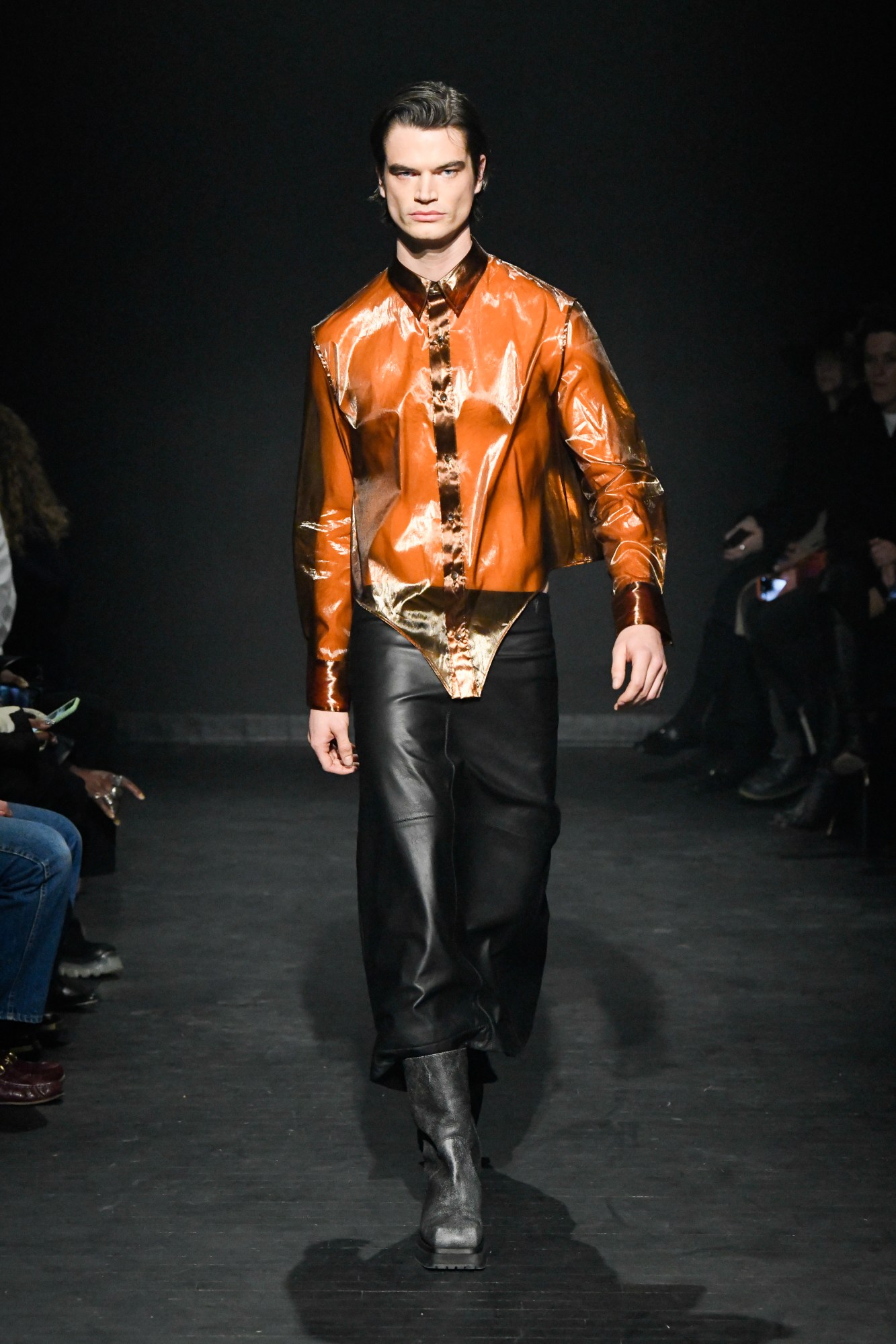
Eckhaus Latta
Eckhaus Latta loves to play with casting, and this season’s lineup featured a special if-you-know-you-know cameo. Jon Gries, who played the Greg to Jennifer Coolidge’s Tanya in White Lotus, made his runway debut. Though it’s unlikely this was a subliminal reference to the show or its subject matter — sex, sabotage, and uh, murder — there was nonetheless a subtle, mysterious tone to last night’s presentation.
Guests entered the fourth floor of Performance Space New York to a dimly lit room that went black as the show began. Show notes featured a poem by New Yorker writer Rachel Aviv, touching on getting dressed and finding spirituality, hinting this collection might be about making space for a moment of reflection.
Models were dressed in Eckhaus’ signature knits, including a chunky pink zipped sweater, soft and sensual mohair pieces in airy shades of mossy green and grey, a cloudy blue cropped sweater quietly revealing a single nipple. There were other nipple moments, too: a zippered sweatsuit with two intentionally placed slits in the chest (à la Regina George’s viral style statement in Mean Girls), a duet of see-through vinyl pieces in amber, and a grey apron dress in the spirit of what one might wear in the kitchen or the artist’s studio.
Fresh propositions came in the form of crunchy, baggy, paint-coated jeans, bell-bottom button-down corduroy track pants and thumbless latex opera gloves. Moving to a soundtrack by Manchester-based DJ due Demdike Stare, models walked a weaving runway punctuated by several platforms, allowing the audience to see the clothes — and perhaps different layers of meaning — from different altitudes. AT
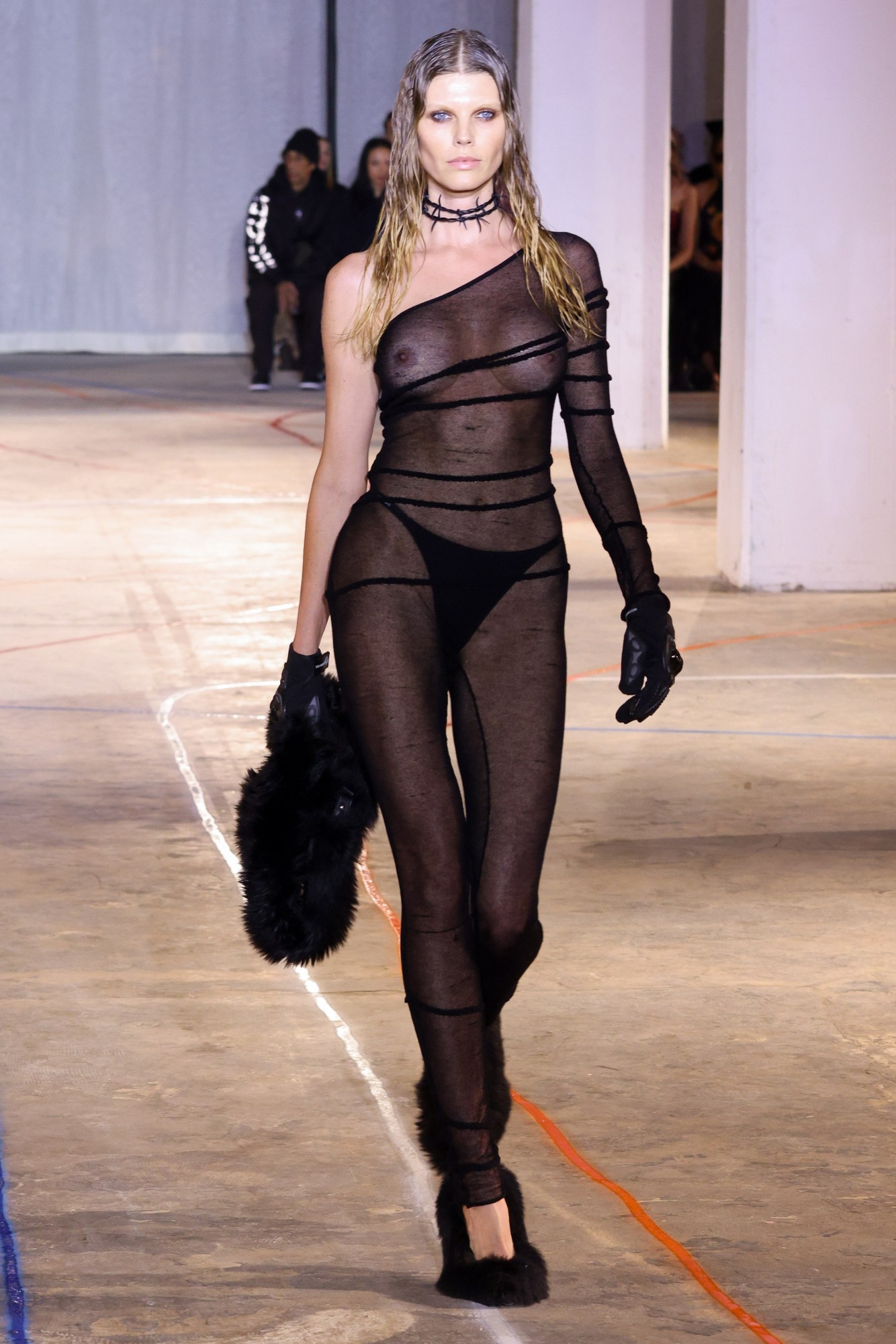


Heron Preston
Heron Preston’s AW23 collection marked his return to the NYFW calendar since his collaboration with the New York Department of Sanitation almost seven years ago. To say the world has changed dramatically would be an astronomical understatement, but Heron says he’s picking up right where he left off. “We’re just continuing to build on what we’ve been learning in the past,” he shared backstage. “Understanding colour, textures — understanding community, the bridging of different worlds.”
All of those elements played a role at the show last night, which really seemed to begin when his front-row celebrity guests like Jordan Woods, Ashley Graham and Jourdan Dunn filed their way into the show space. With roots as a downtown insider — and one of the founding members of DJ collective Been Trill — Heron certainly looks to the unique individuals that make up the ever-intersectional world of New York and its creative community for inspiration.
He played on this theme through a bit of theatre and cosplay, opening (actually his first-ever runway show) in earnest with two men in city worker uniforms. He soon joined them both, wearing the same orange safety vest, as the three of them spray painted what would become stage marks for his models. They entered the chat in looks you’d see at a cool party in Soho or Bushwick, blending technical pieces like nylon vests with workwear like double front trousers, sprinkling in more sensual notes like a chainmail bikini top, black fur snow boots and a leather thorned choker. Key to this season’s offering was the styling — a black hoodie worn with a black puffer, black shades and a black satin dress; a mini skirt worn over sweatpants; a graphic tee reading “NYC” layered over a long-sleeved waffle shirt; a crisp white Oxford emblazoned with “HP” in big, electric blue lettering, worn with a black skinny tie and matching blue racing gloves. The goal was to take everyday sportswear in as many directions as there are people on the subway.
Perhaps the most memorable look was a character in a zipped hoodie, frayed skate pants, orange gloves and a worn white ski mask holding a vintage camcorder, as they filmed both the action on the catwalk and people in the audience. “I really wanted to have a perspective from the runway. When you watch back a runway show, it’s always coming from the outside. To have someone inside I feel is much more engaging,” Heron said after the show. Making what’s happening “inside” the culture accessible and available is what this brand is all about. AT
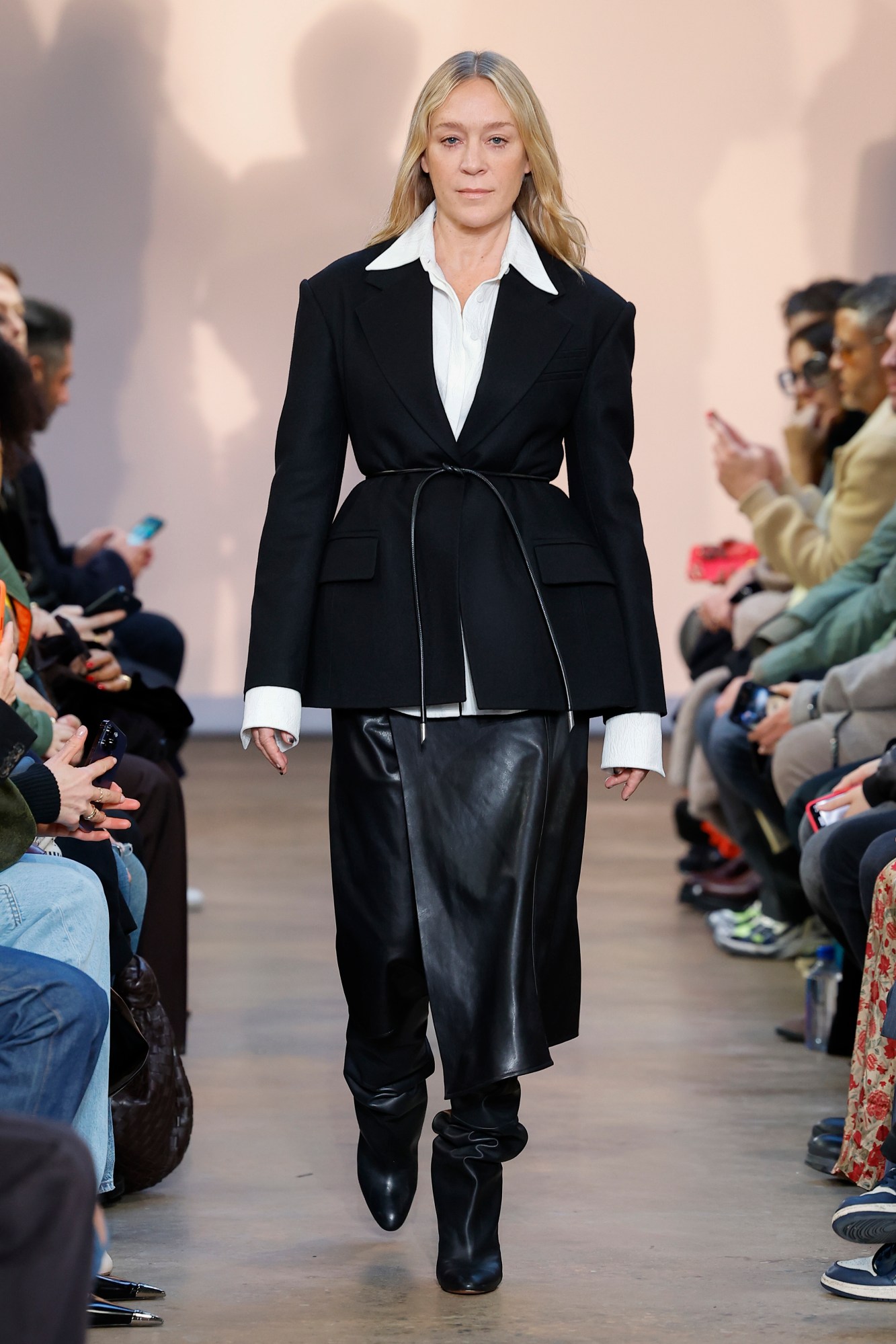

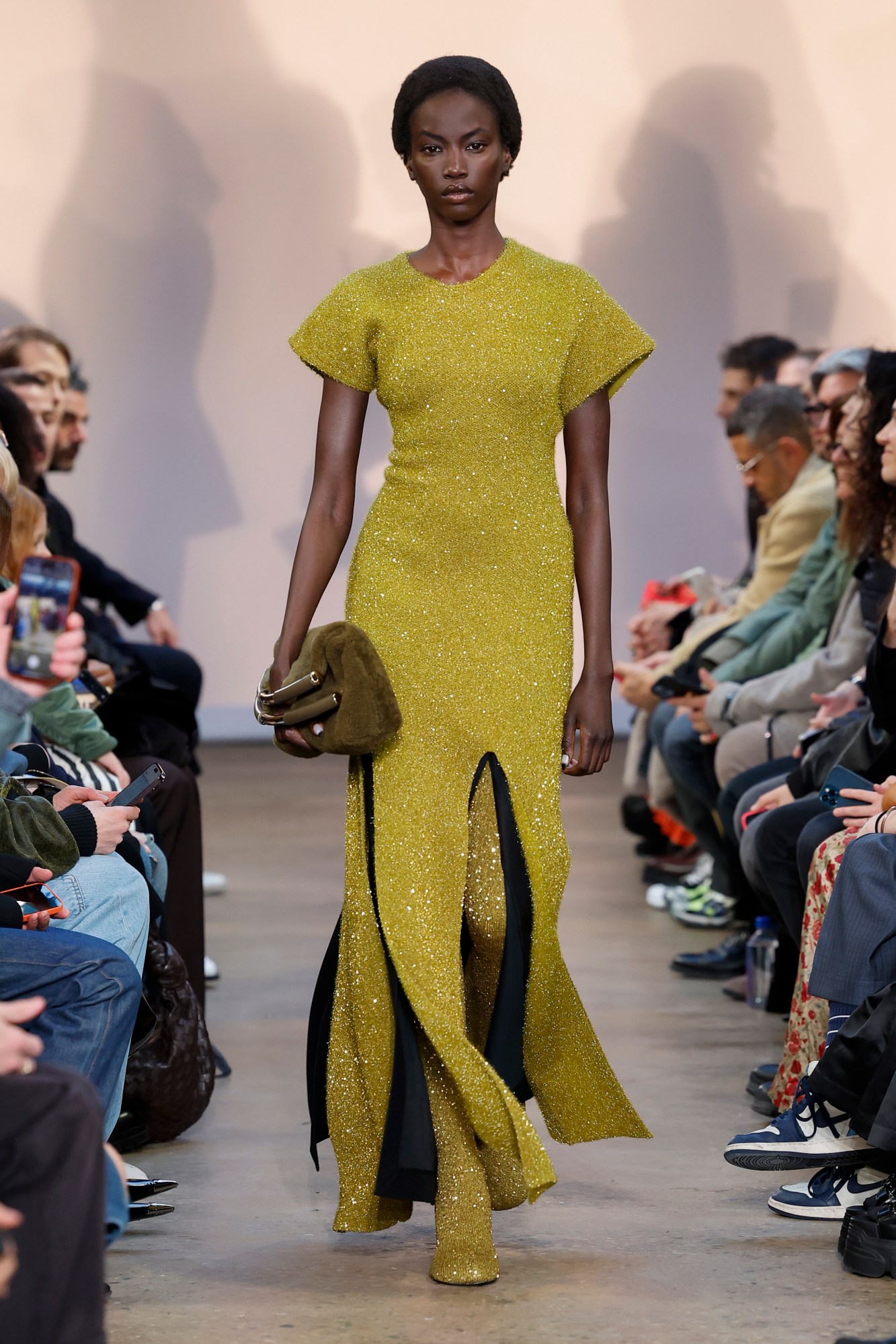
Proenza Schouler
To mark 20 years of Proenza Schouler, Jack McCollough and Lazaro Hernandez decided to pull back the curtain. Their AW23 collection was presented in the airy and bright Chelsea Factory, in which everyone in attendance sat front row – they wanted us to be as close to the clothes as possible – and a transparent wall brought the buzz of backstage front and centre. It was about intimacy and honesty, the cornerstones of what the designers hope to carry into the next decade of the New York brand.
“We’ve grown up in front of all of you guys,” Lazaro said after the show, noting that the collection marks a new, more adult era for each of them. “We kept saying it was our most personal collection in that it’s kind of how we dress, how we live, how we look. It’s how our friends, how real women wear overcoats, jeans and boots.”
The collection is devoid of any theme or specific visual narrative, other than to create a complete wardrobe “of clothing we find compelling and essential right now.” The starting point was the influential women within the Proenza Schouler universe, like Chloë Sevigny, who opened the show in grown up, working girl layers: a sumptuous wide lapel jacket and leather skirt over tall-but-slouched boots, and sculptor Olympia Scarry, modelling the same look, this time in all white, cinched at the waist with a custom, crushed metal and leather belt. Both women appeared on their moodboard and from there the duo sketched separates as opposed to full looks. For the first time ever, they focused on the idea of creating an external shell – what does that look and feel like, today?
Set to a series of fictional journal entries by Ottessa Moshfegh, read and recorded by Chloë, then transformed into a musical composition by Arca, Jack and Lazaro made the case for minimal, elevated dressing, in the form of everyday suiting, oversized wool coats and skirts, slit up the sides – blazers were slit up the back, too – and leather separates, paired with chunky knit hoodies and folded over totes. The latter, a modern take on the popular PS1, which is due for a renaissance, we might add. Of course, there were flourishes as well, splattered prints and pom poms lined the hems of of the eveningwear, velvet collared tops and dresses were “ice-dyed” in cobalt blue and amber, scrunch-y metallic dresses moulded to the body and a series of refined, sequined evening layers closed the show.
“We want reality; we’re tired of all this fantasy and Instagram clothes, and like, everyone not wearing clothes,” Lazaro said backstage, laughing, in between congratulatory hugs from friends and family. Though the collection itself was a touch more sombre than seasons past, it was clear the overall mood was pure joy. ND


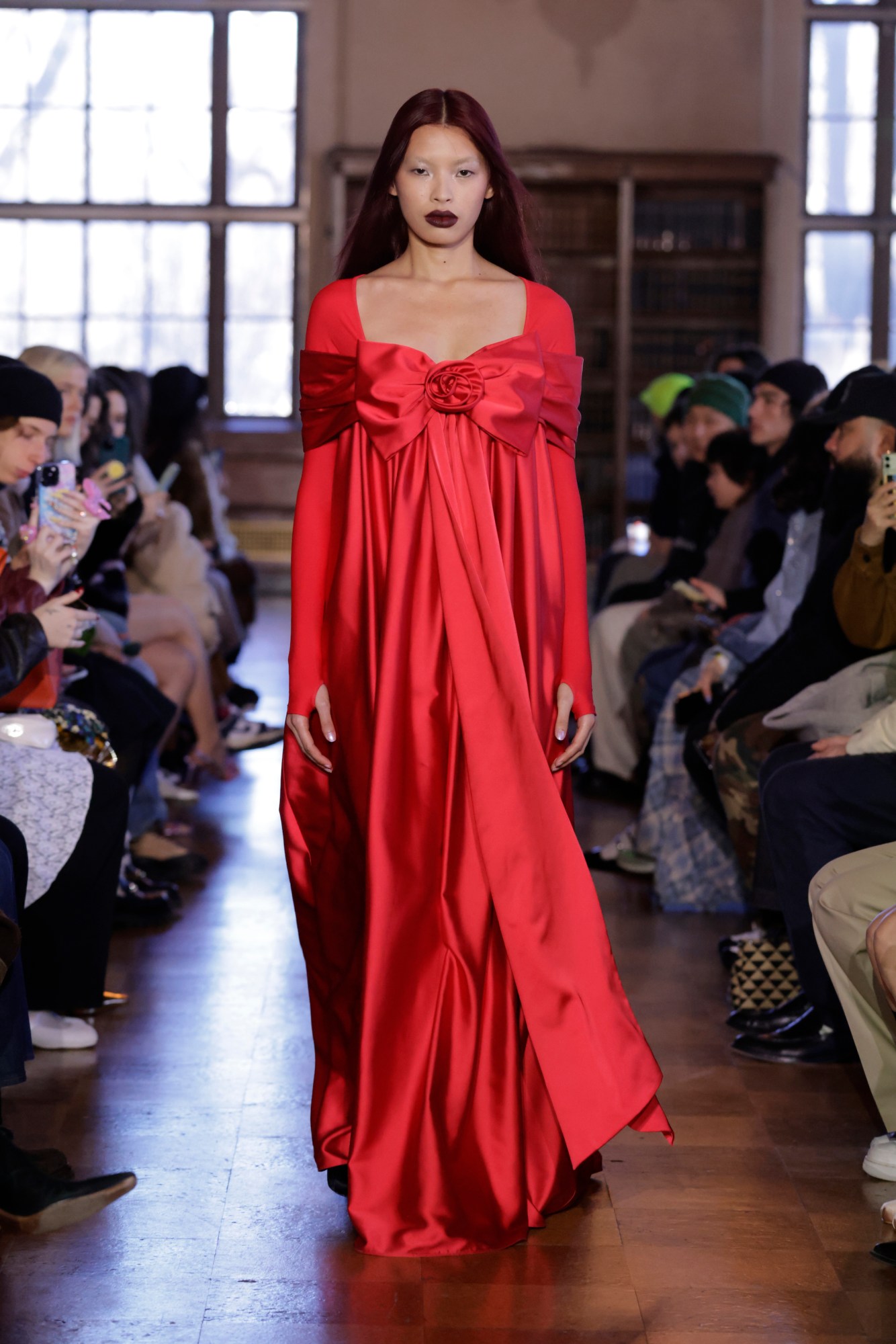
Sandy Liang
Last season, after debuting her very first pair of shoes – the Mary Jane Pointe Shoe, in leather and satin pastels – wheat-pasted ads cropped up all over New York City, featuring the footwear with knee-high tights, often paired with the label’s sweeping hair bows and soft feminine silhouettes. At her AW23 show, held at the New York Academy of Medicine in the Library Reading Room, where massive wooden shelves full of leather-bound books lined the walls, Sandy Liang’s pale pink, yellow and blue ballet flats dotted the frow; the crowd very much proving that coquette and balletcore aesthetics are still alive and well among the downtown set.
The romantic vibe translated to the runway, albeit inspired by “the drama and grandeur of the Renaissance”, where Sandy showed cap and Juliet-sleeved babydoll dresses, sporting satin rosette sashes, lace and eyelet ruffled layers and pleated micro minis, paired with leg warmers, taffeta bow bags and cropped bolero collared knits. The idea anchoring the collection was to create an everyday uniform, suggesting “you can do anything in a dress”, especially when paired with trainers and mesh slip-ons the designer’s made in collaboration with Salomon Sportstyle. Elsewhere, she made the case for the colour red – in long sleeve, gloved tops, a stunning draped sleeveless dress, complete with rosette at the hip, and her first evening gown, a floor-length column dress, the model’s arms tied down with a massive bow at the neckline.
Though rather saccharine — as is to be expected from Sandy Liang — the tied up details, and all black looks, in which models wore netted rosette fascinator hats and opera gloves added a darker, more subversive tone, especially when soundtracked by Hole’s “Doll Parts”. Whether or not you like and subscribe, the past couple collections have elevated the designer’s singular vision and this sort of world-building deserves a round of applause. Well done, Sandy Liang. ND

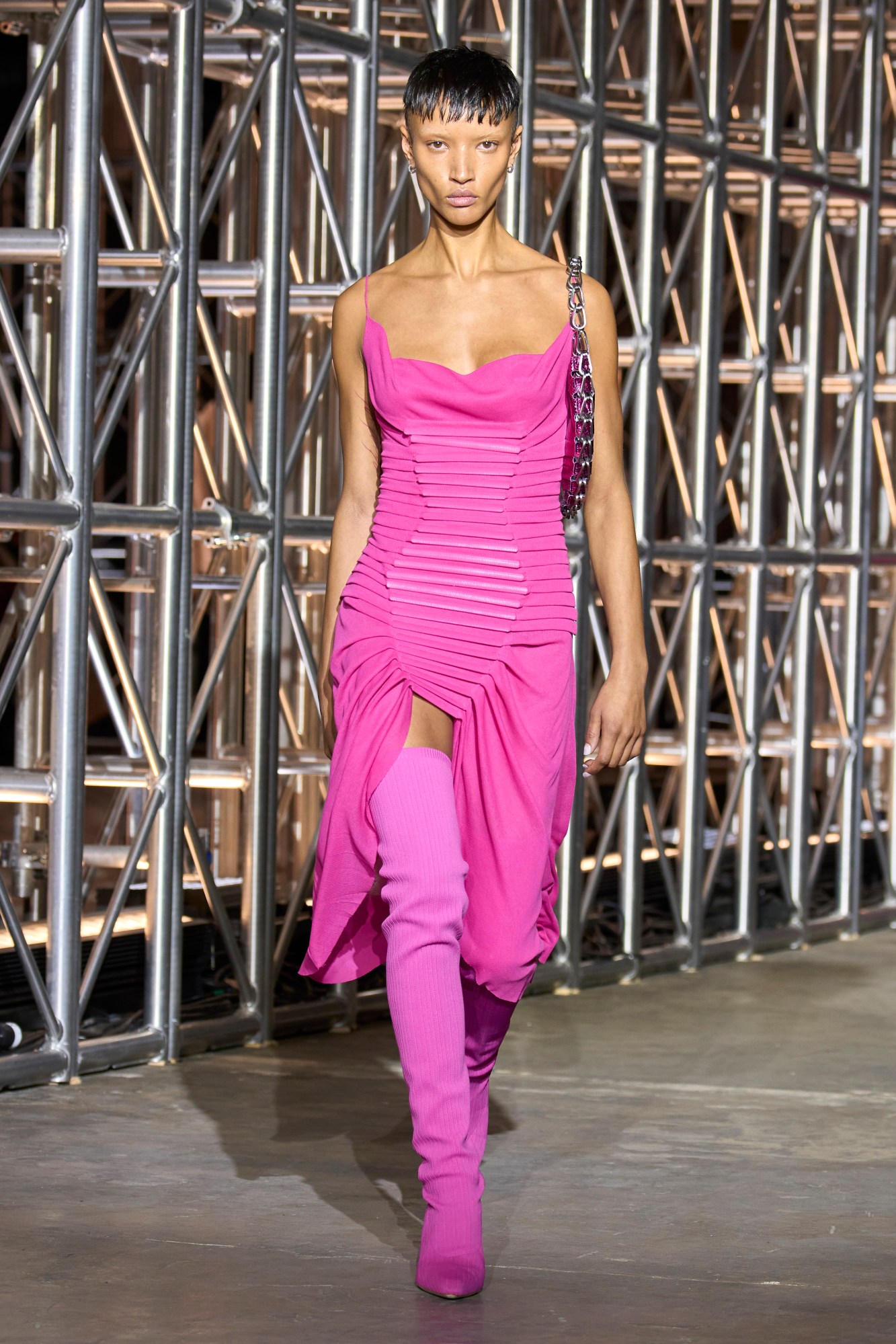
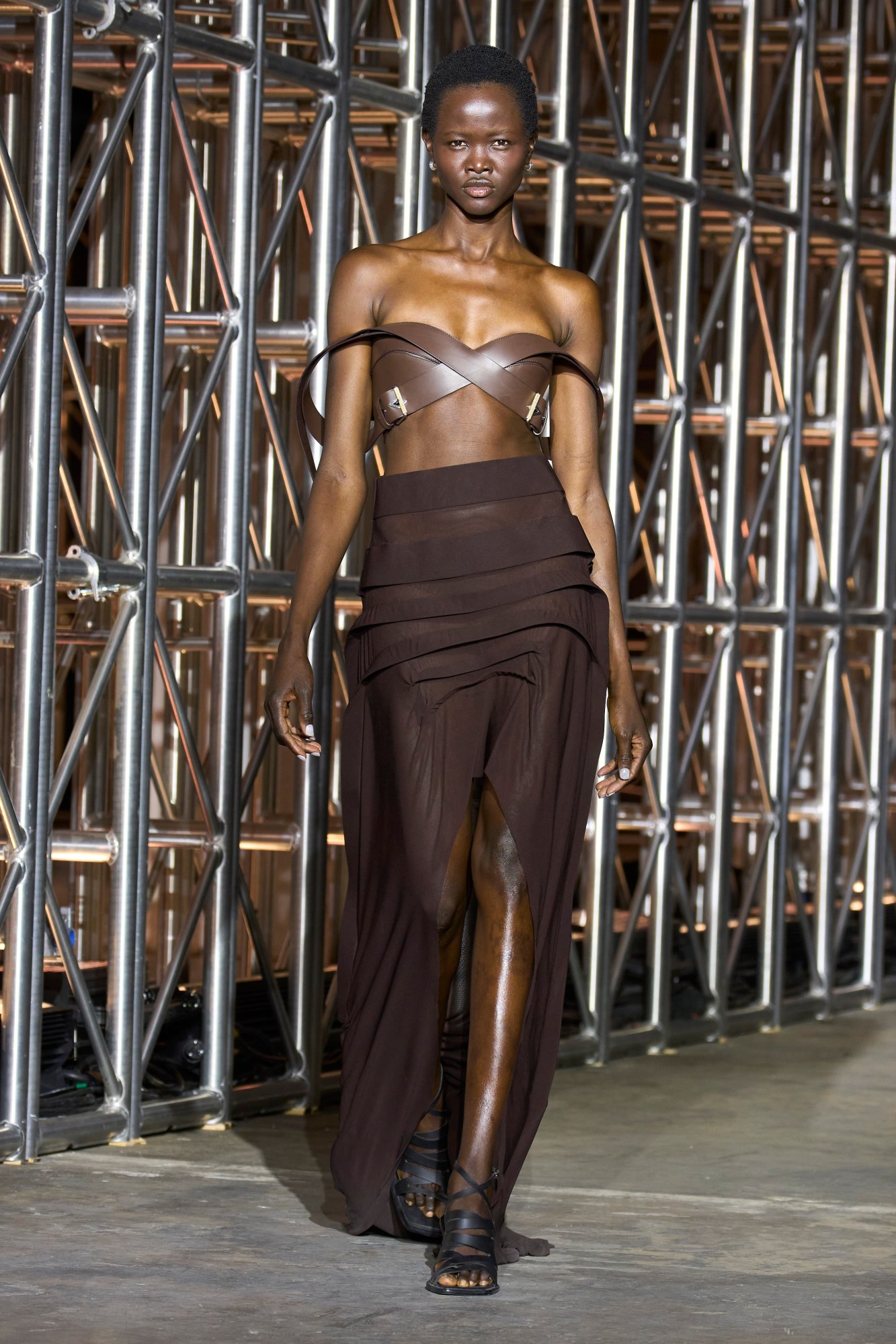
Dion Lee
As we have come to expect, Dion Lee’s latest offering played on the tension between baring skin and covering up. A focus on reptilian textures uplifted the former—showcasing snakeskin scales in short, grommeted cocktail dresses and thigh high boots. There were also graphic crocodile pieces in pure white, bubble gum pink and black, rendered as skirts (a column maxi, a lace-up mini), simple zip jackets, a longline trench, and an abstracted mesh, gloved bodysuit. There was no shortage of Dion’s signature cutouts, with sheer gowns revealing shoulders and whatever the sensual area right below the clavicle is called. A cinched periwinkle dress threaded with a thick cable cord was a dreamy standout. Dion’s outerwear saw a few fascinating points of exploration, including a bubble puffer jacket in clear coated vinyl and an angular shearling mini jacket that garnered audible praise from the audience. This show certainly made the case for the adage that sexuality is just as much about what you can see and what you can’t. AT
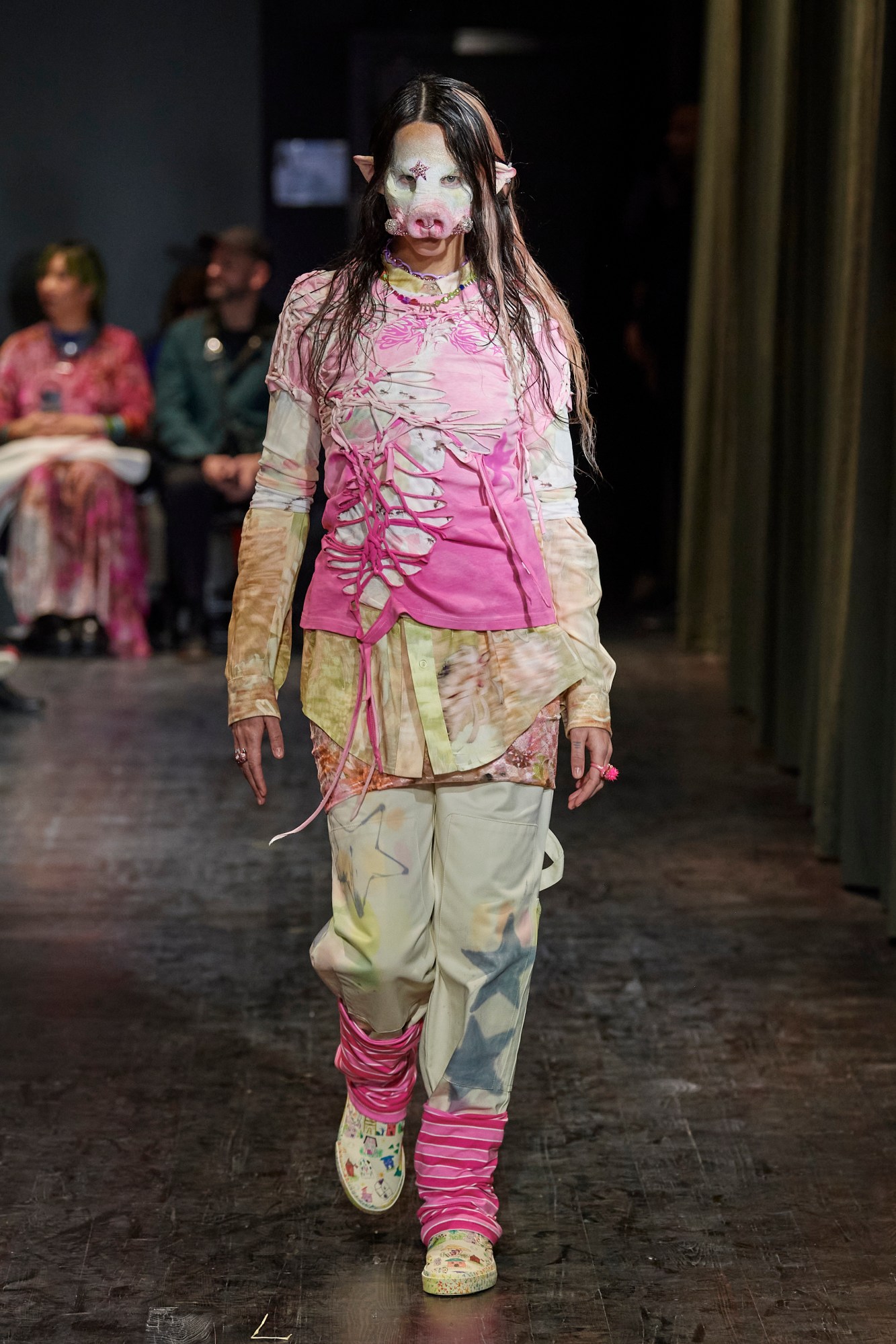
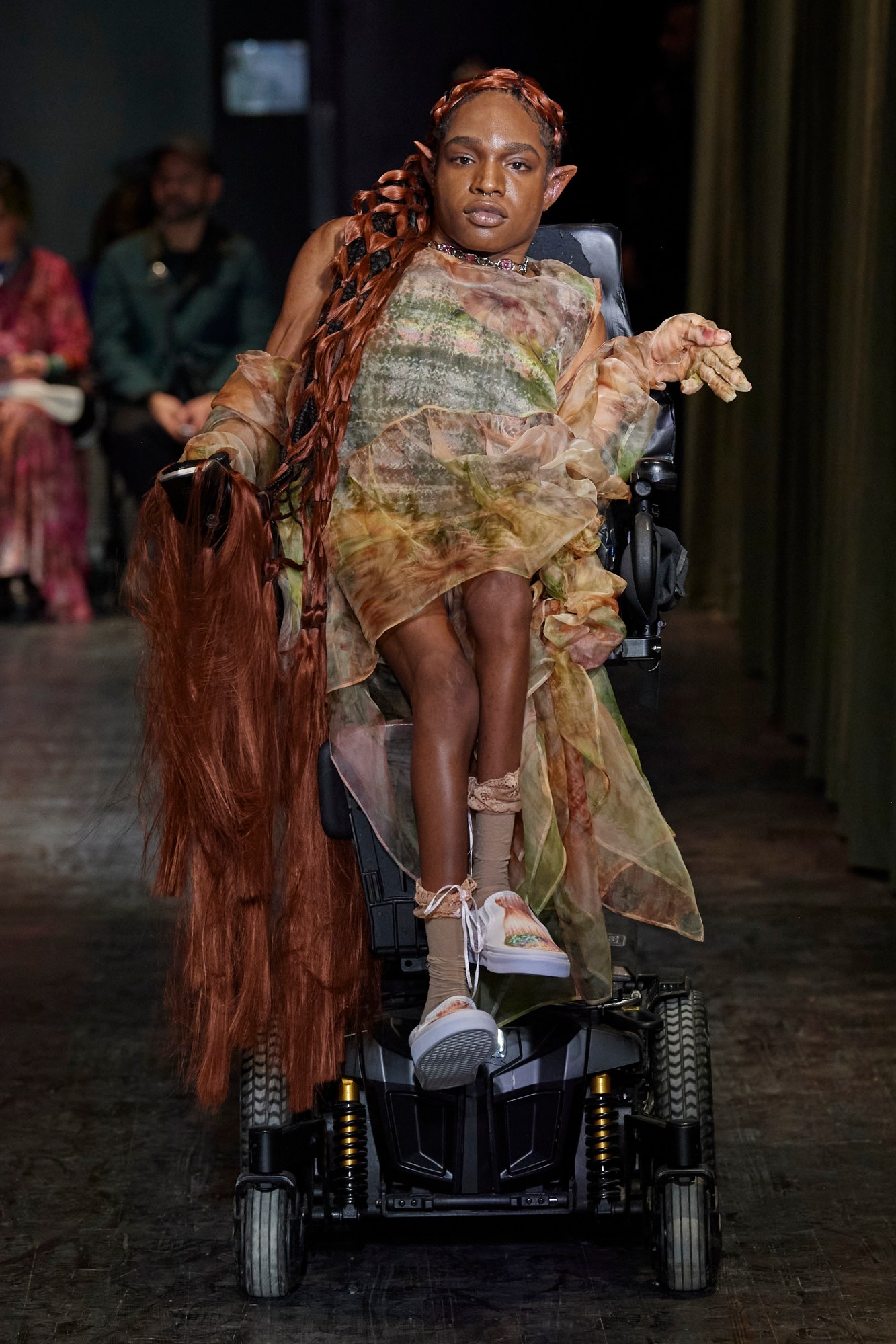
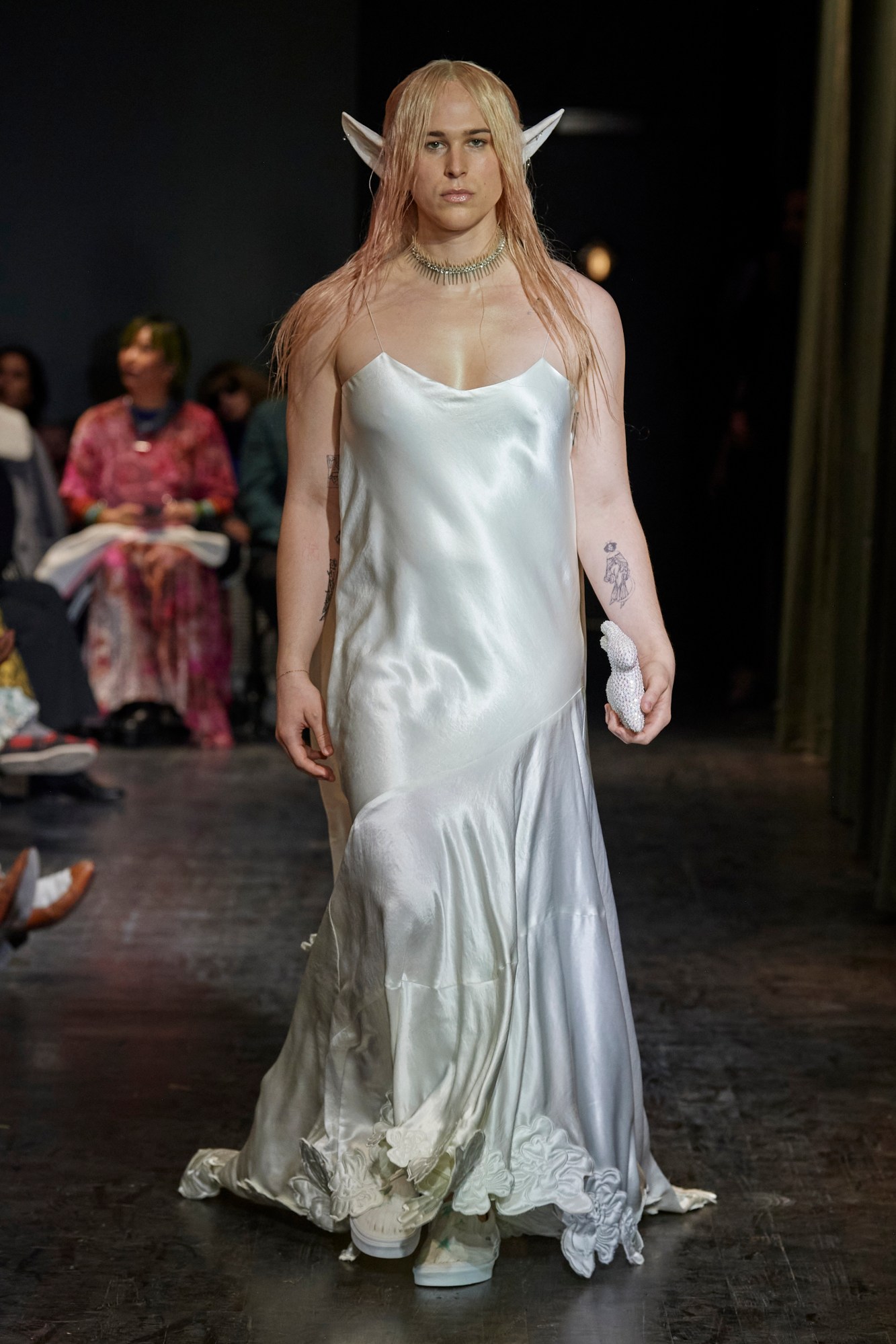
Collina Strada
By now we’re all extremely familiar with Collina Strada’s affinity for the environment. Her AW23 collection, Please Don’t Eat My Friends took this fascination to new heights, expounding In-Real-Life on the “Animorphs” trope she explored digitally for AW21. With help from experimental makeup mastermind Isayama Ffrench, models were transformed into fashion animals and nature nymphs. Complete with psychedelic prosthetics, they crawled, bounced and slithered down the catwalk in new shoe offerings created in collaboration with Vans.
Somehow, none of this distracted from the clothes, which felt both fantastical and yet more wearable than ever. The show began with earthy, caramel tones, jumping from mesh bodysuits, silky brushed prints and velvets, to tartan plaid trousers and a slinky satin dress with soft sculptural horns adorning each shoulder. Collina’s actual dog made an appearance on the runway, introducing literal animal printed graphic tanks with, one of which was in his likeness. Scaly, minty green and mustard yellow prints rendered in lace camisoles, corsets, frilly bloomers and cropped sweatshirts moved the collection into brights, followed by further experimentation with plaid—in frosty blues mixed with muddy browns and traditional patchwork pieces that felt sourced from vintage archives. Standing out were intricately knit tees and dresses that recalled the expansive, almost terrifying, growth patterns of forest fungi.
“You know that fun fungus fact about how everything is connected by microscopic little filaments under our feet?” read the show notes. “How flora and fauna live together in an intricate, non-linear, non-hierarchical, yet tenderly delicate and complicated balance of mutual benefit and connectivity? How we’re all in this together…” Spectacle aside, it’s a gorgeous vision of a reality in which we humans live in concert with the ancient rules and wisdoms of the natural world. AT
